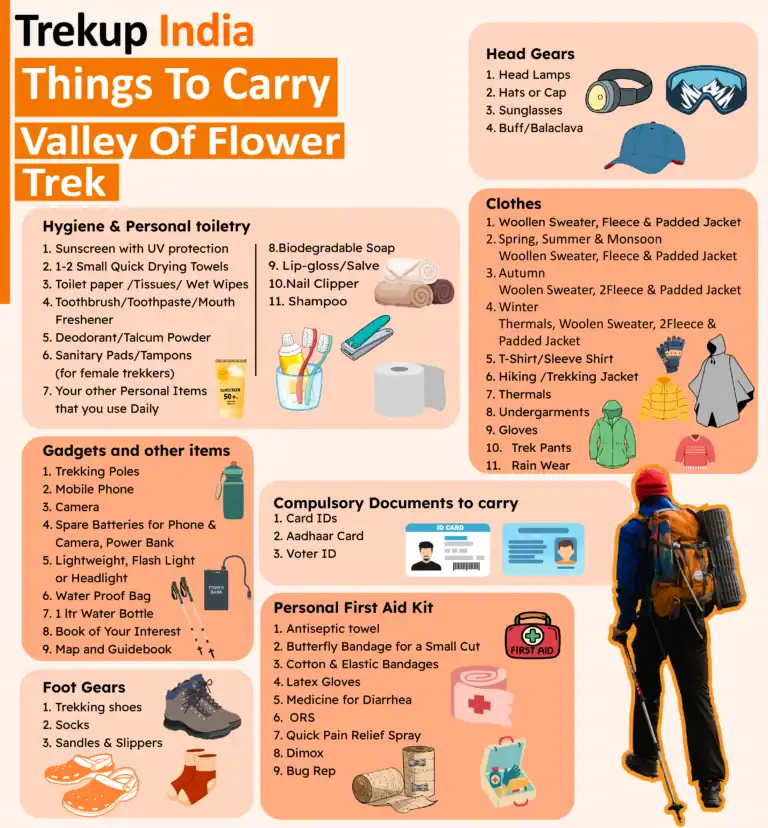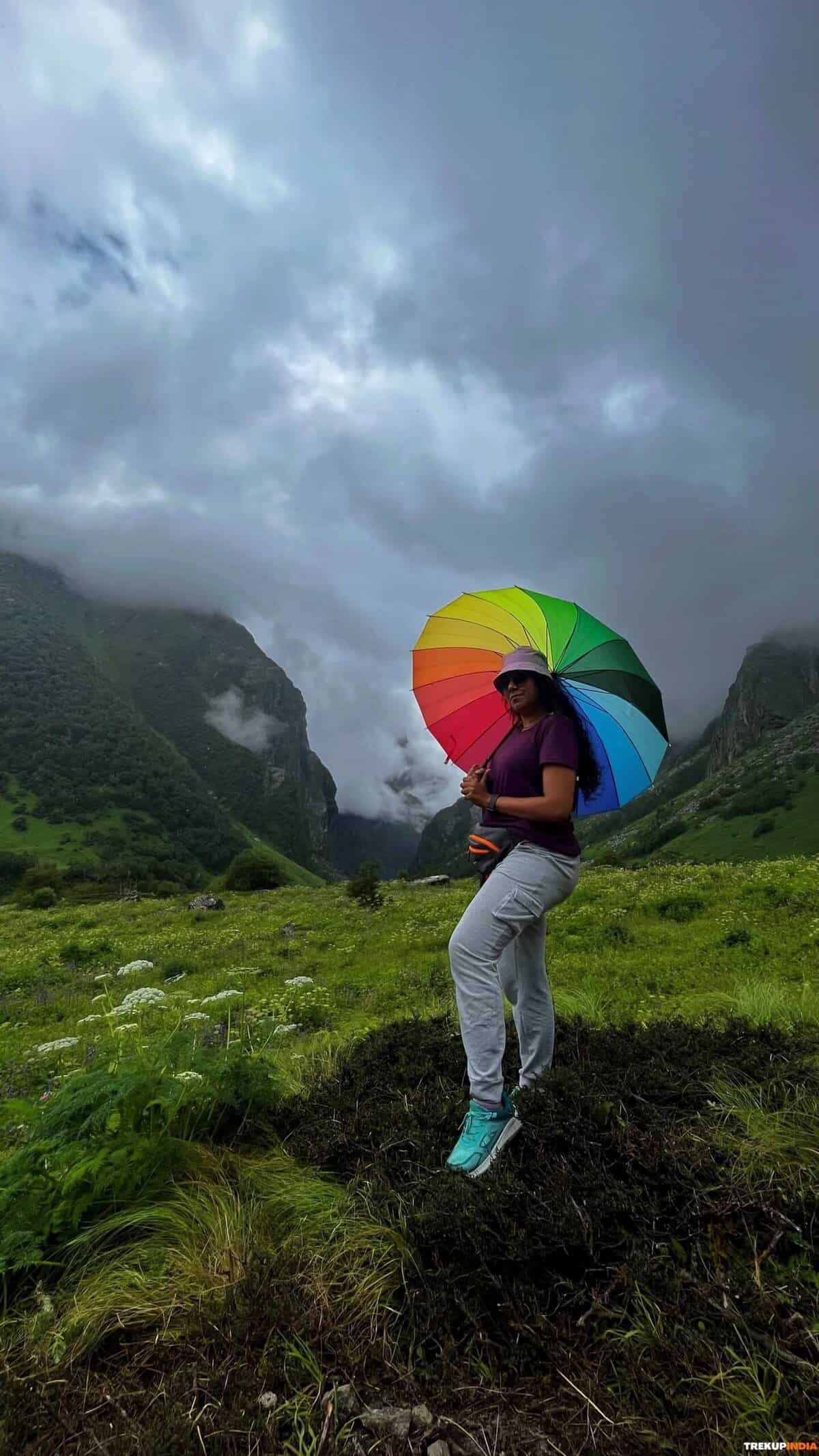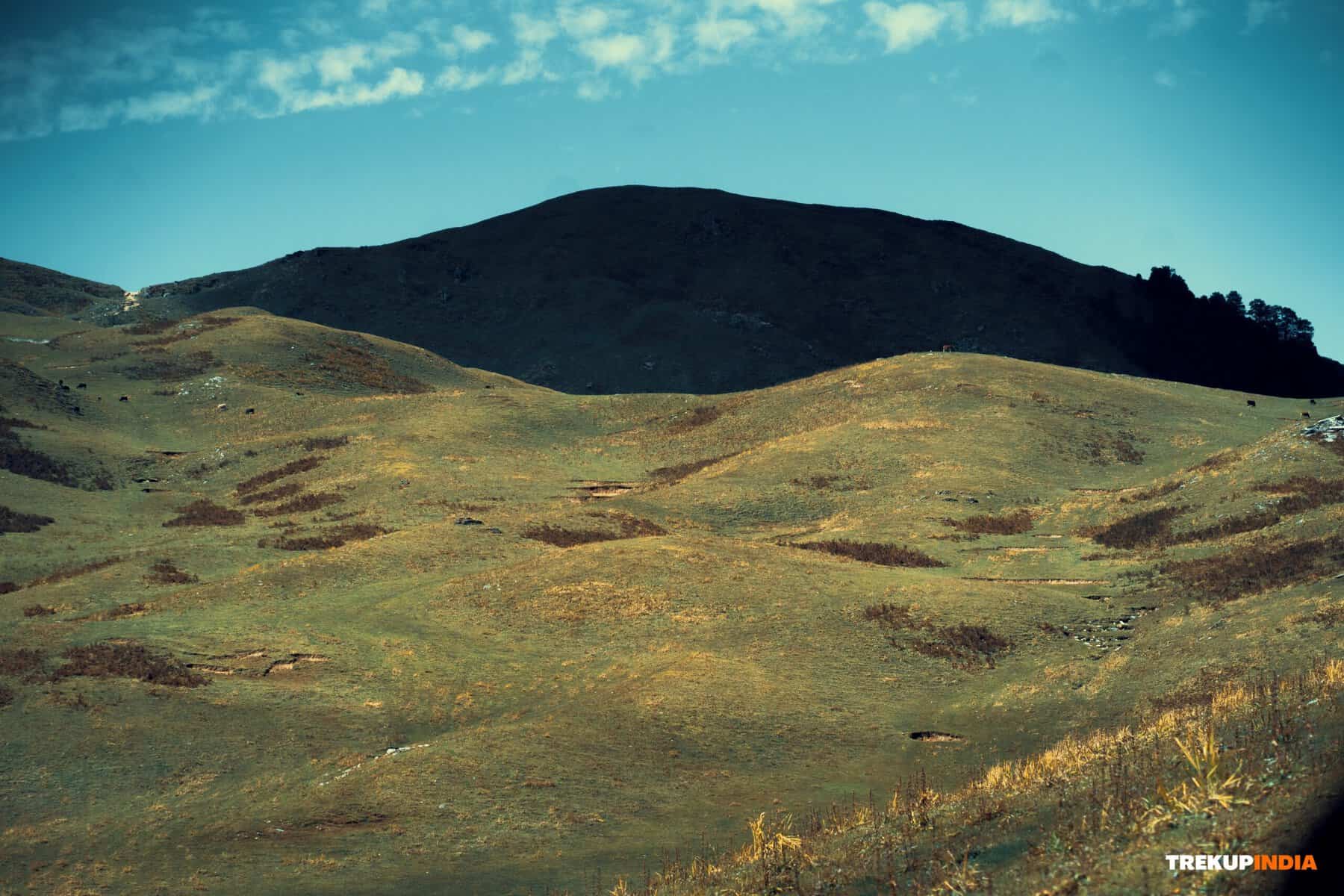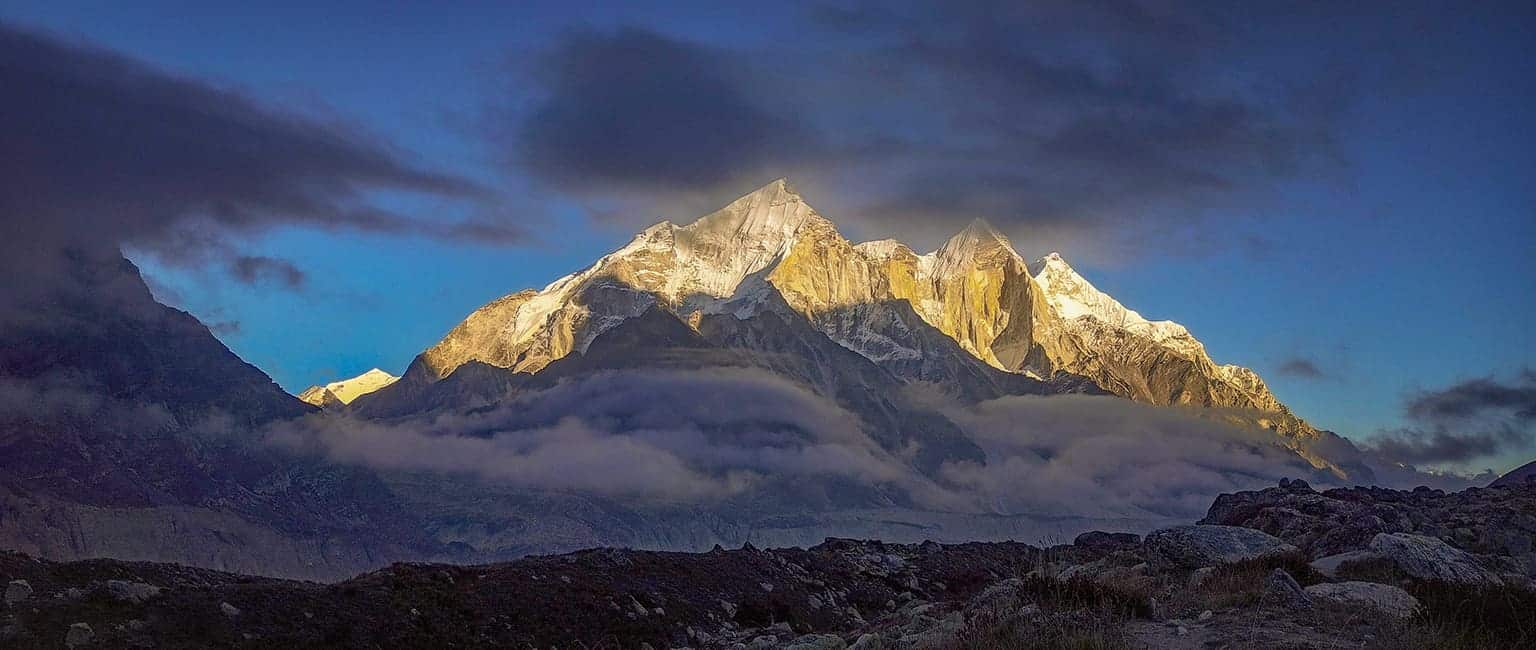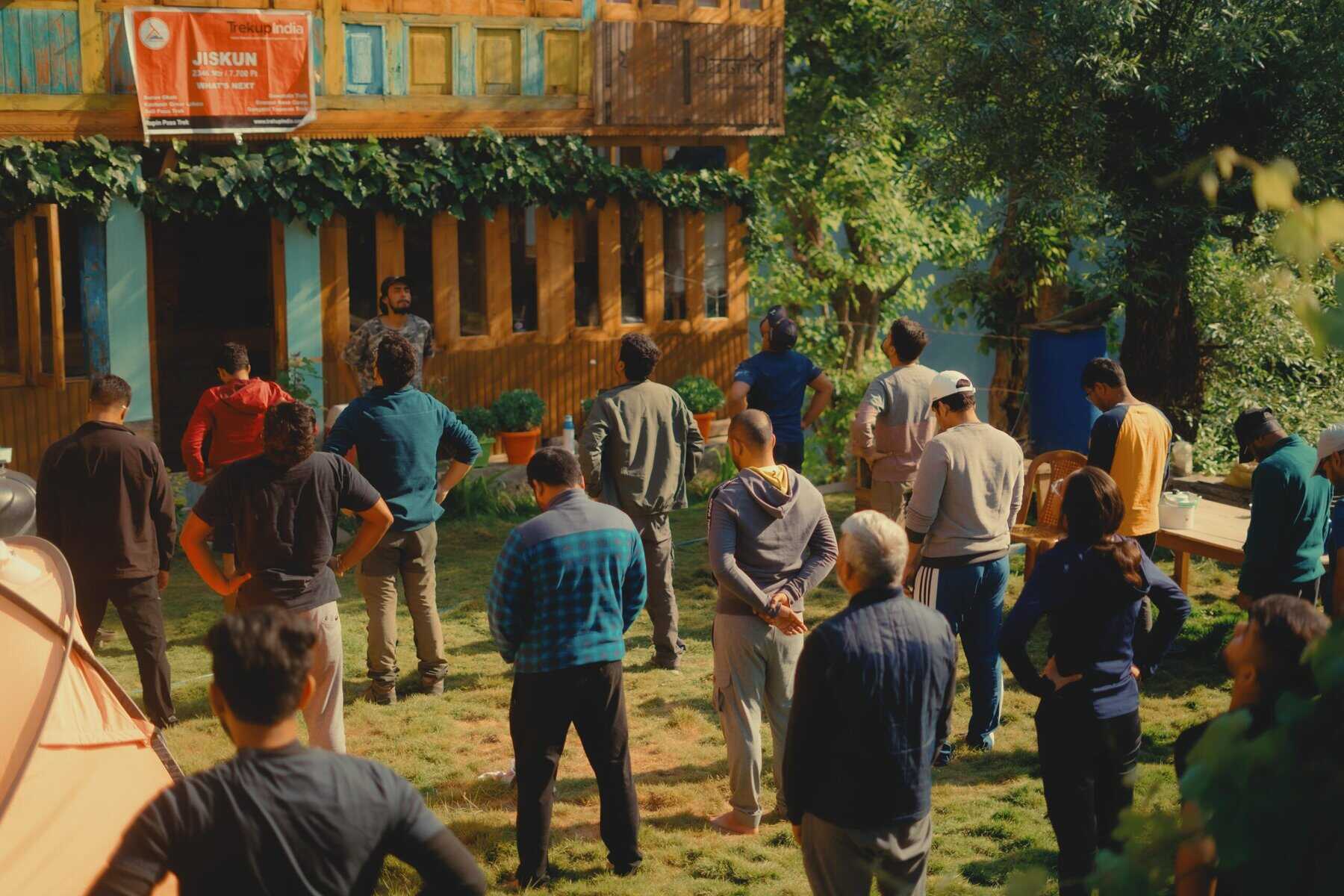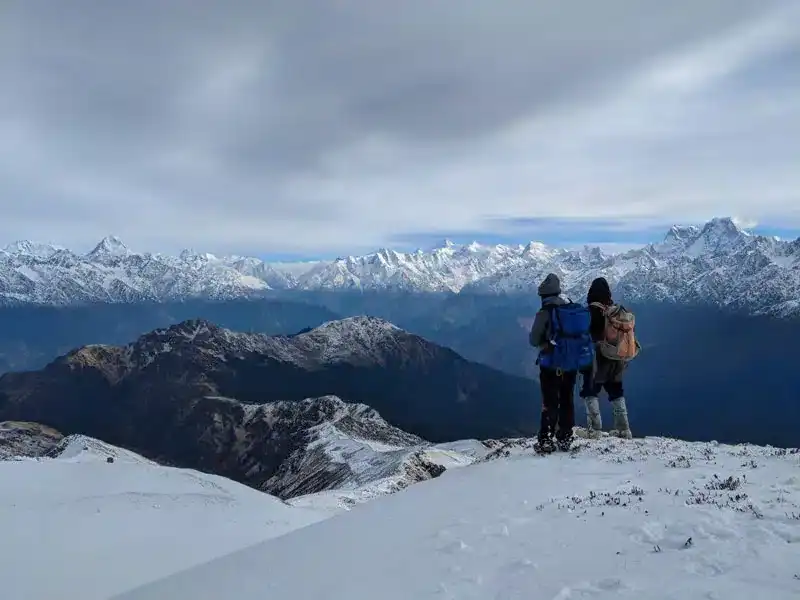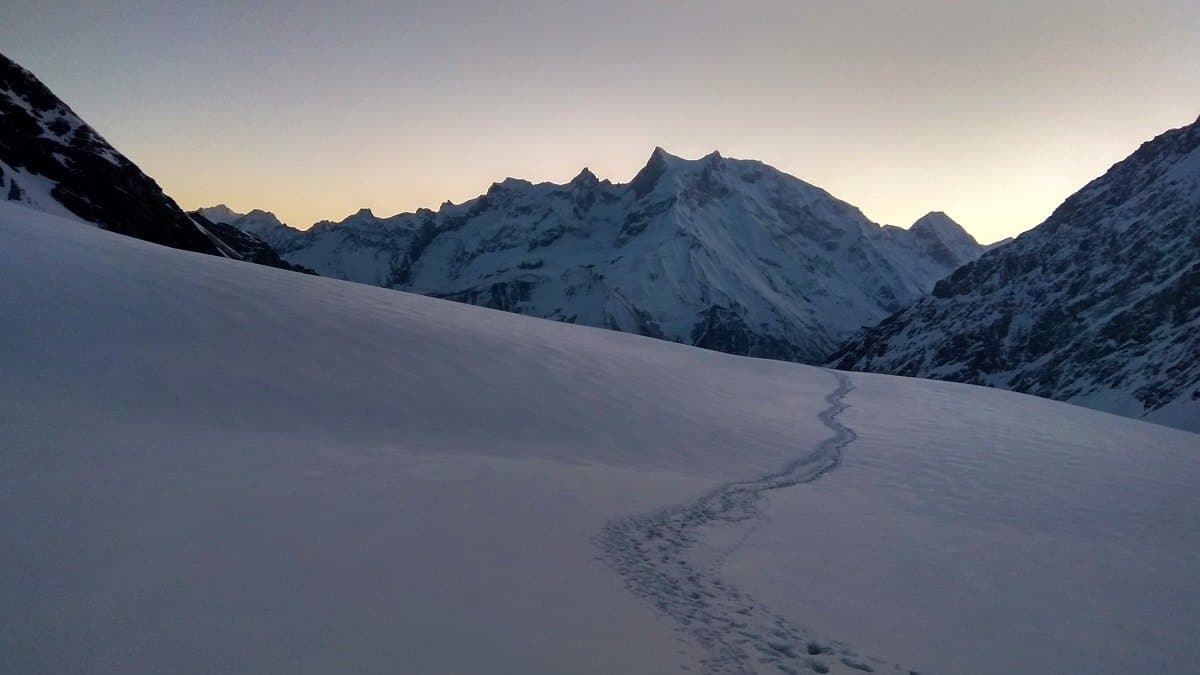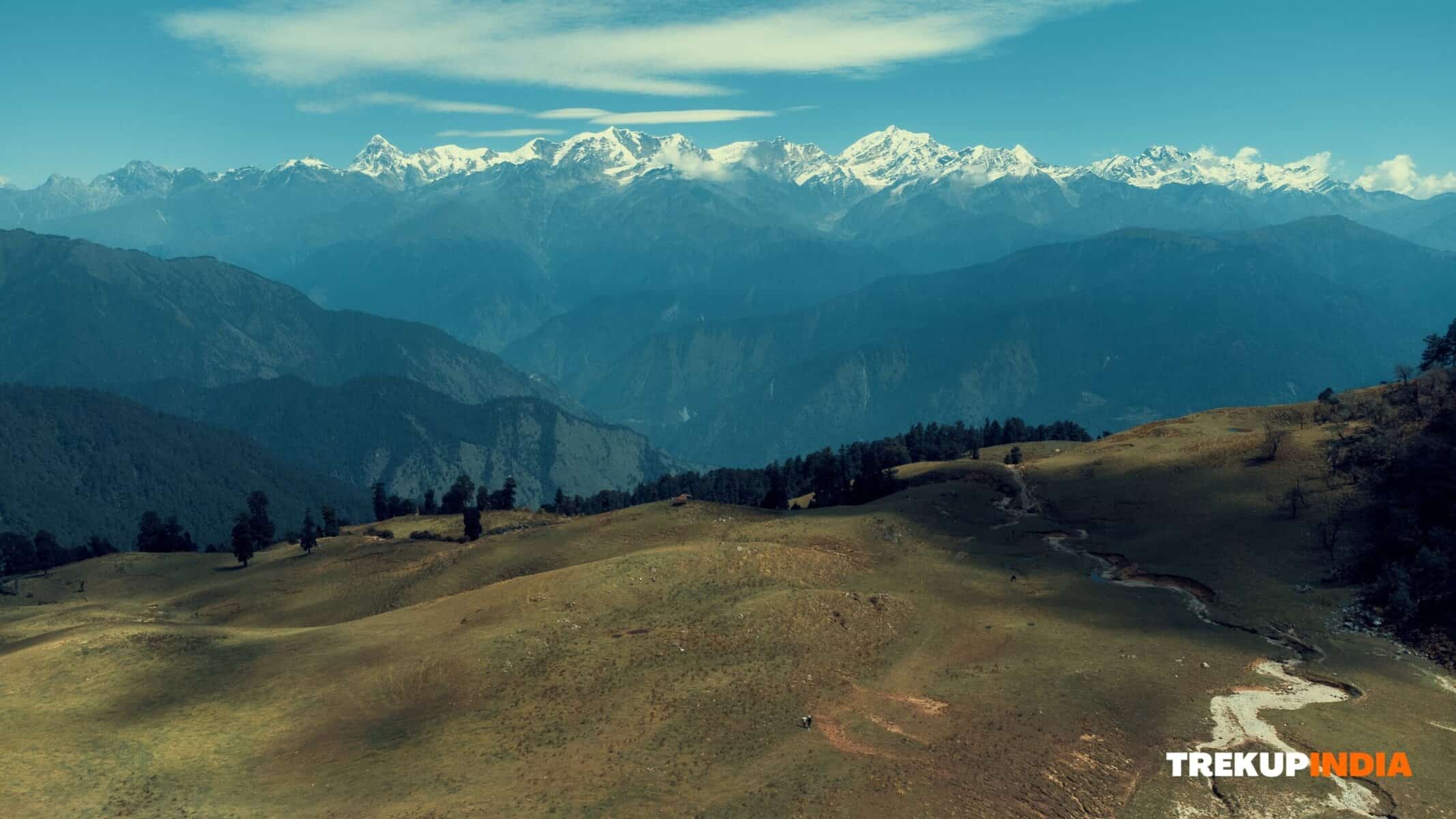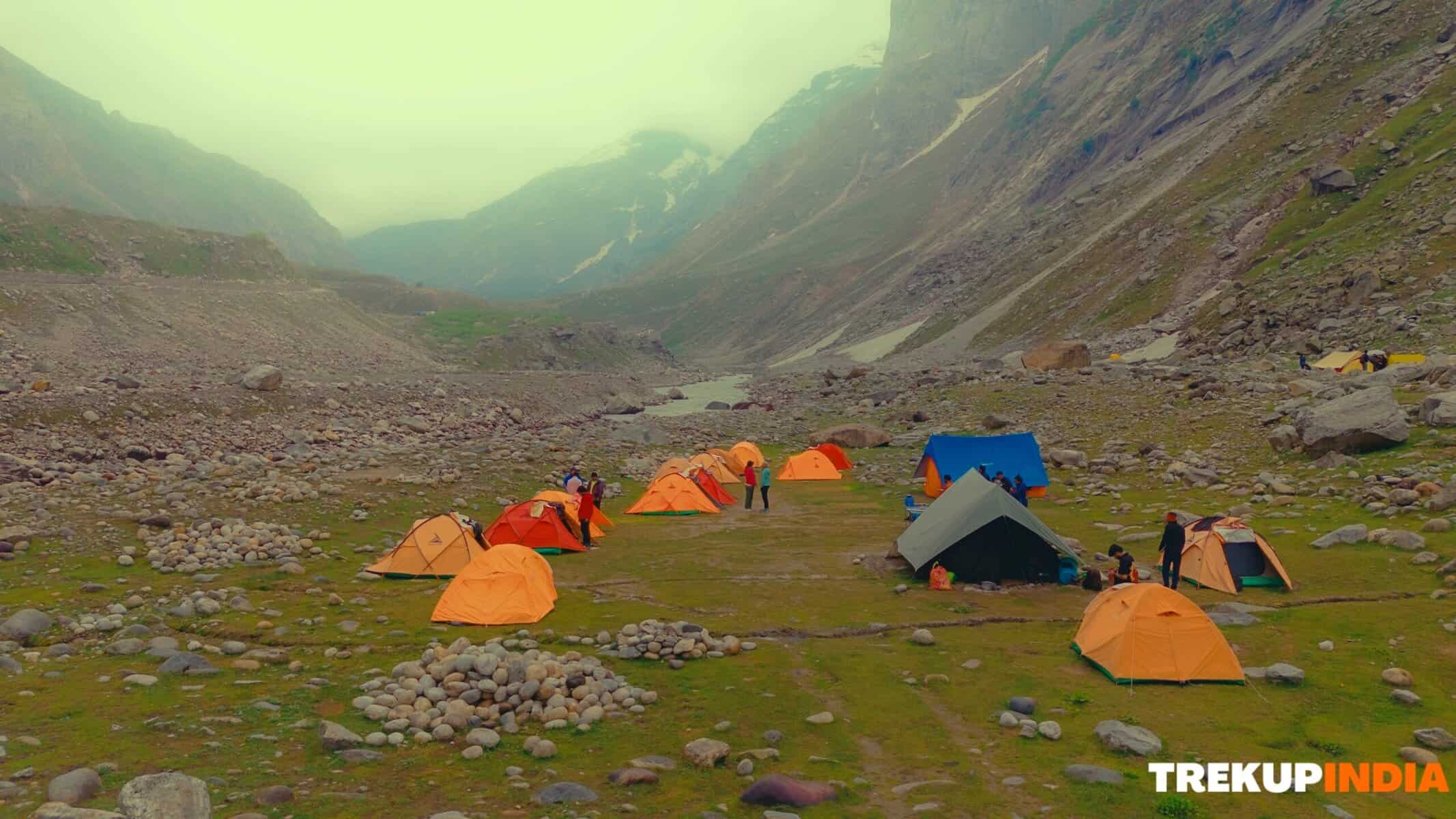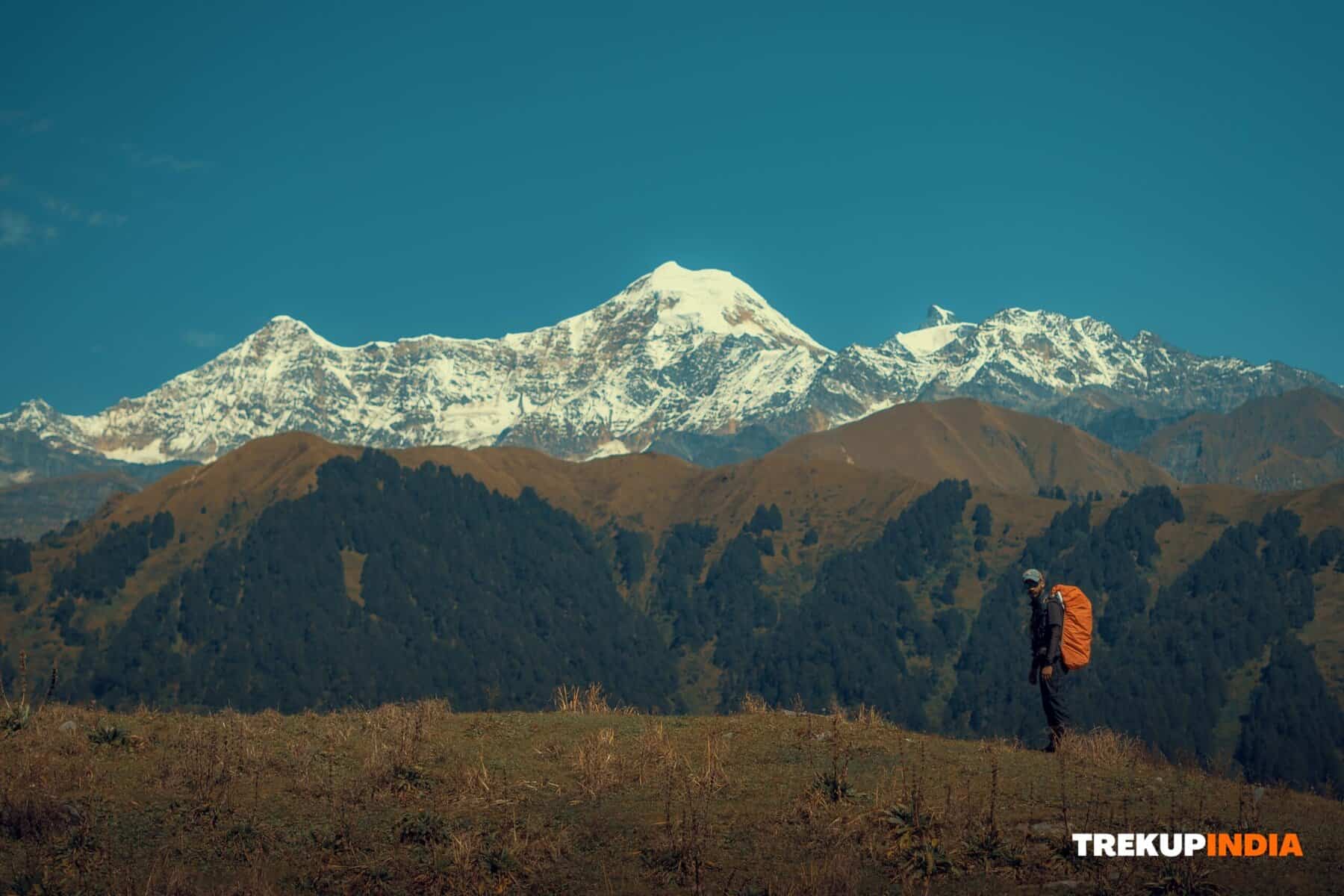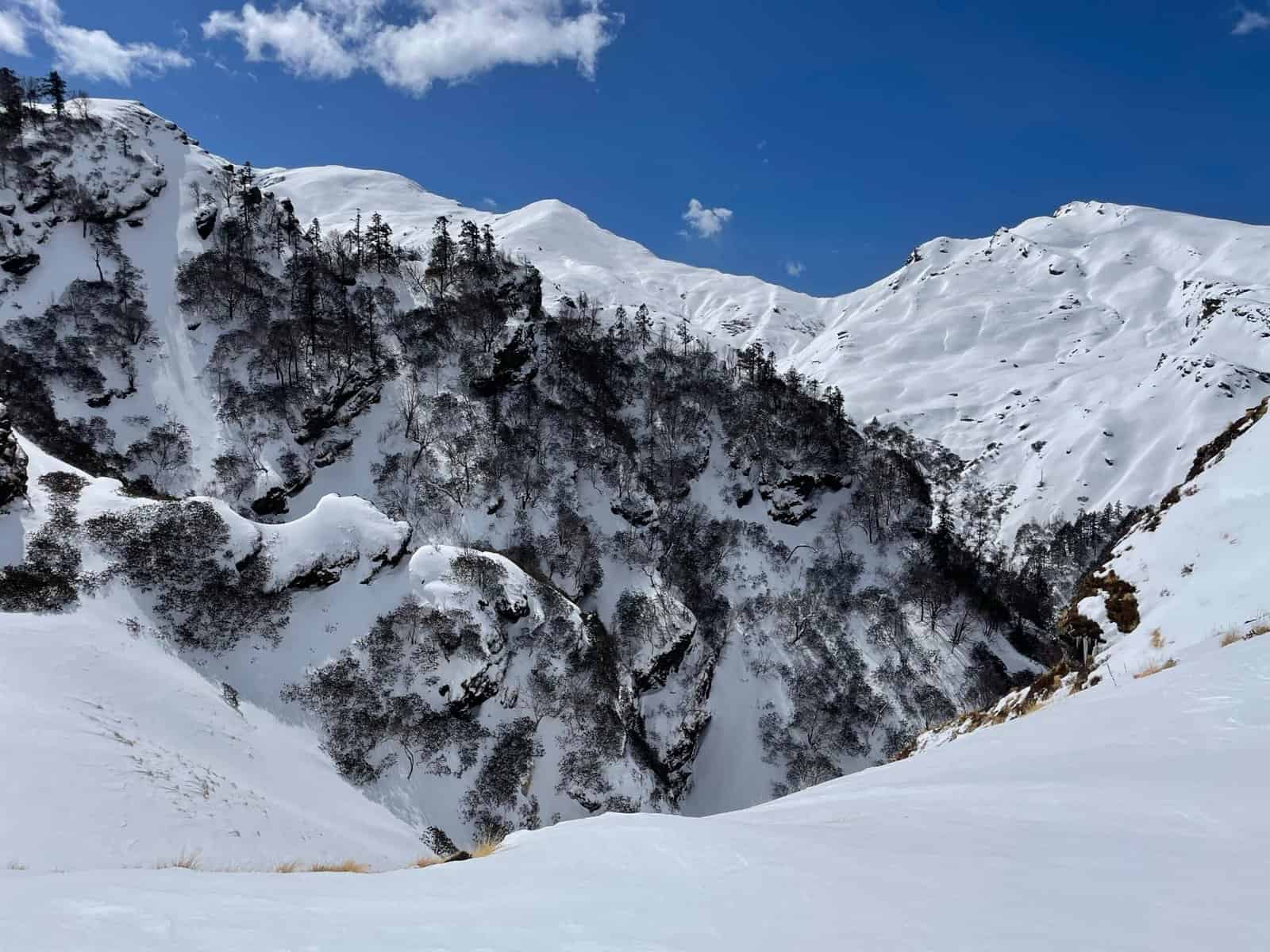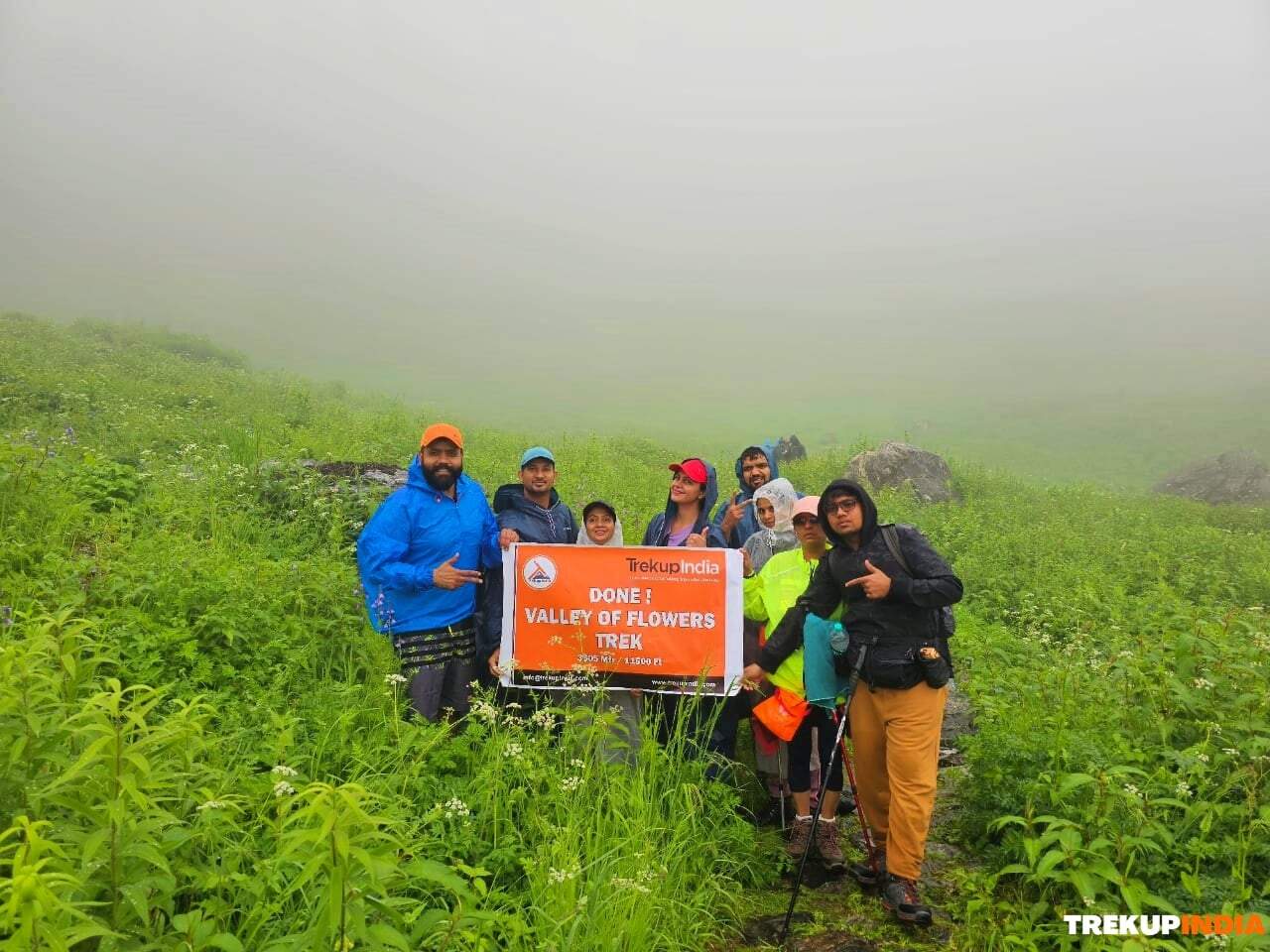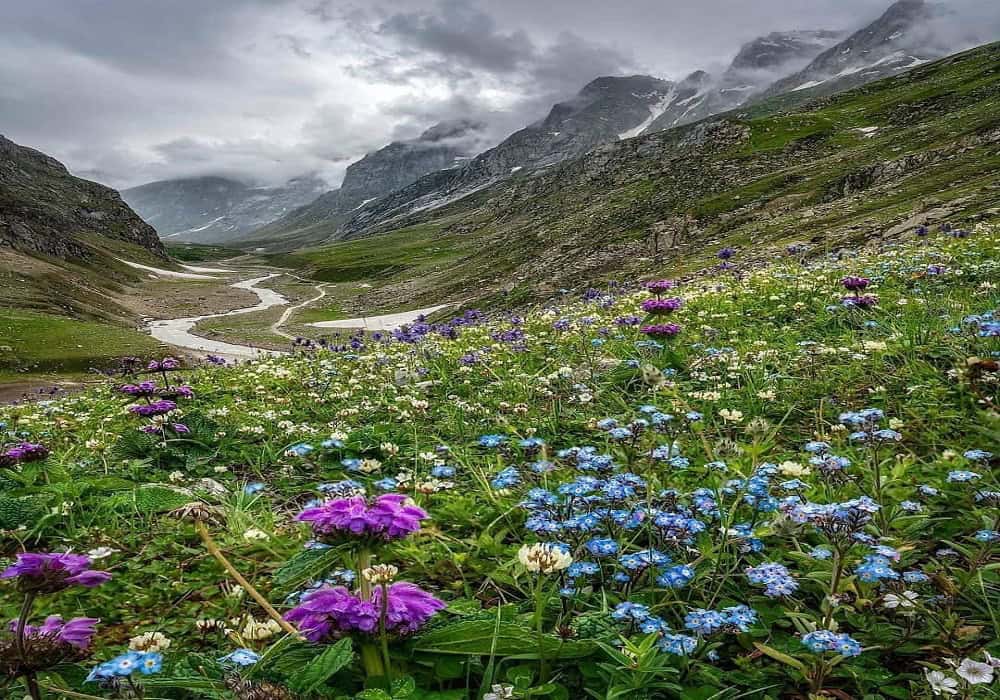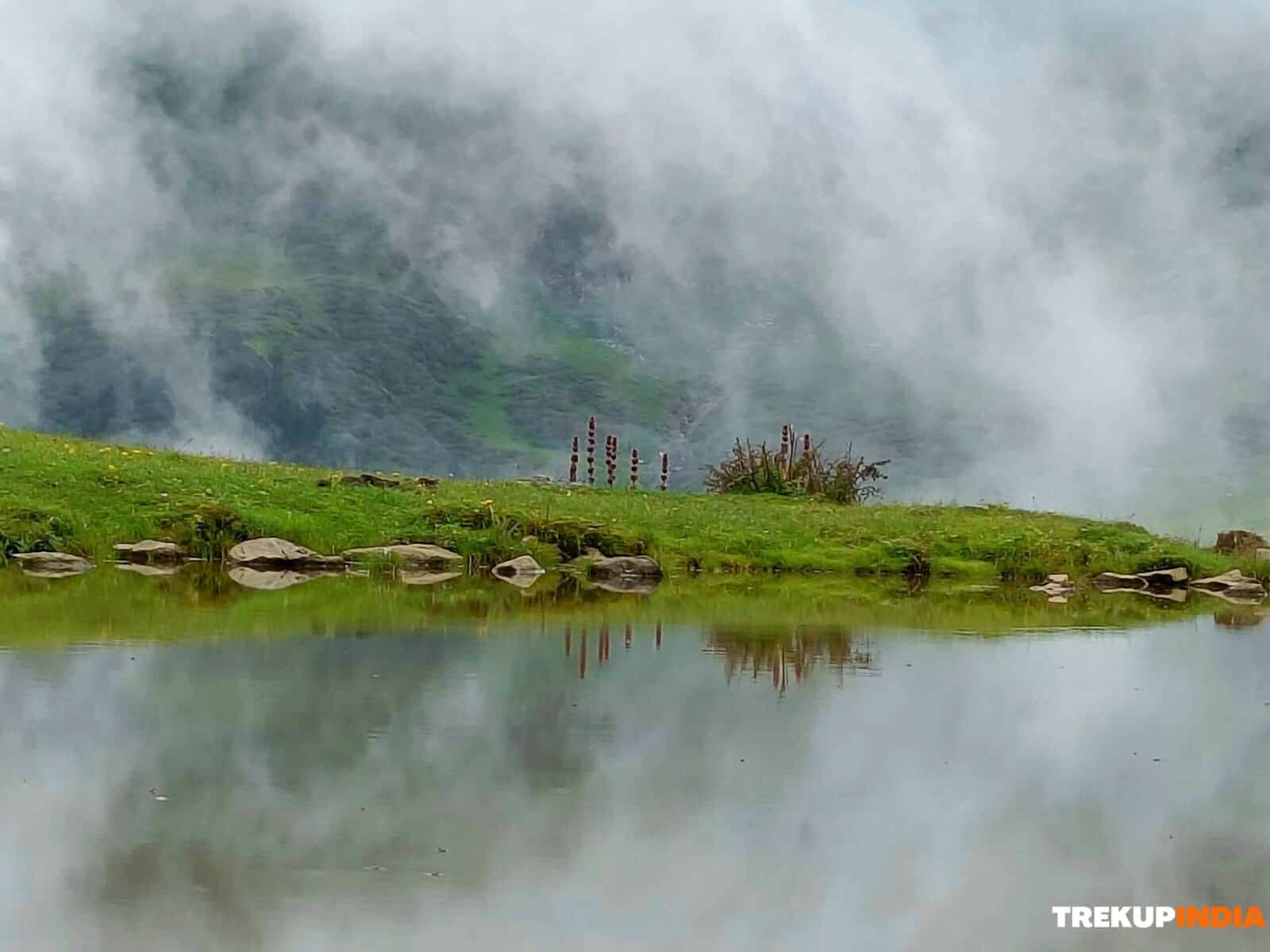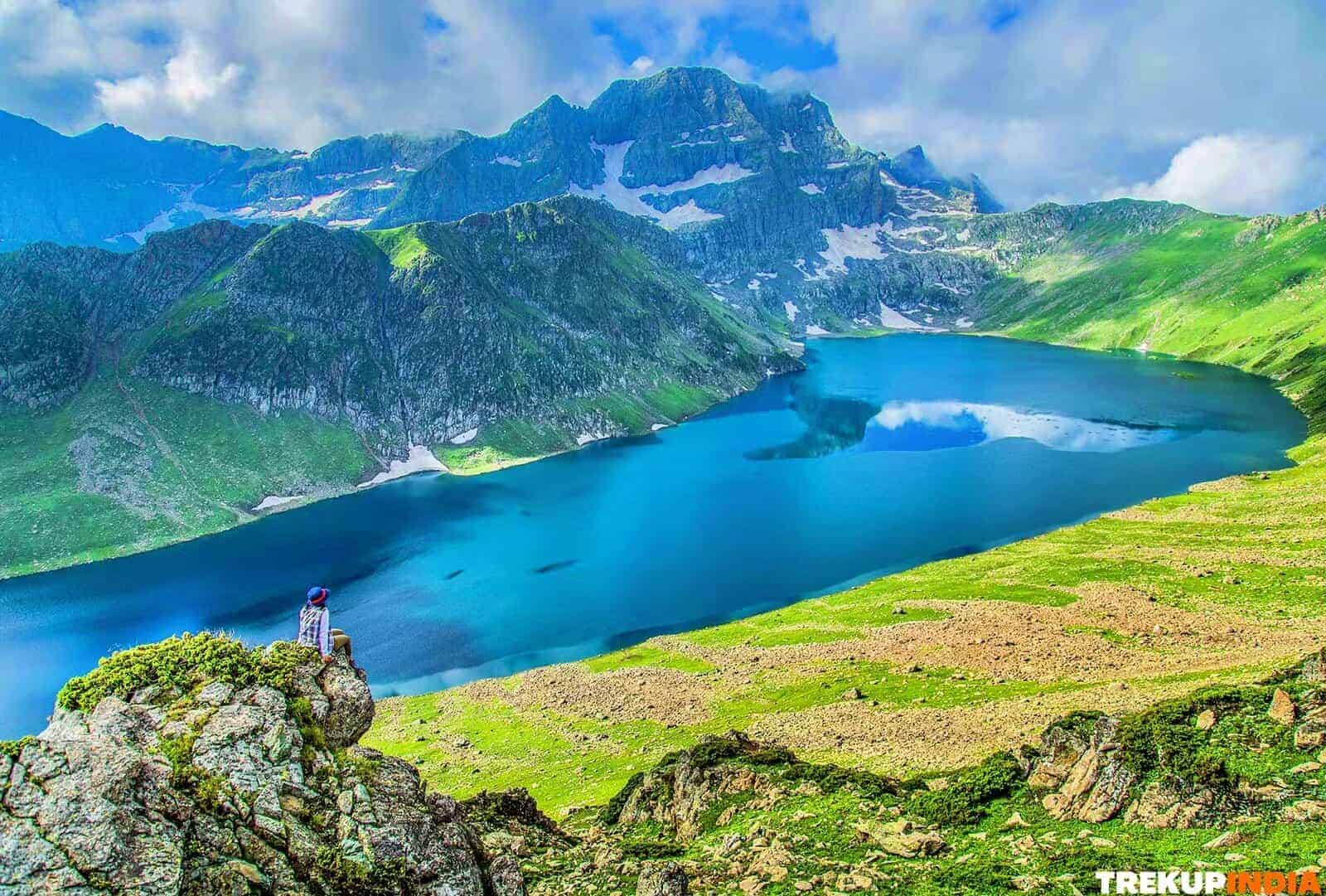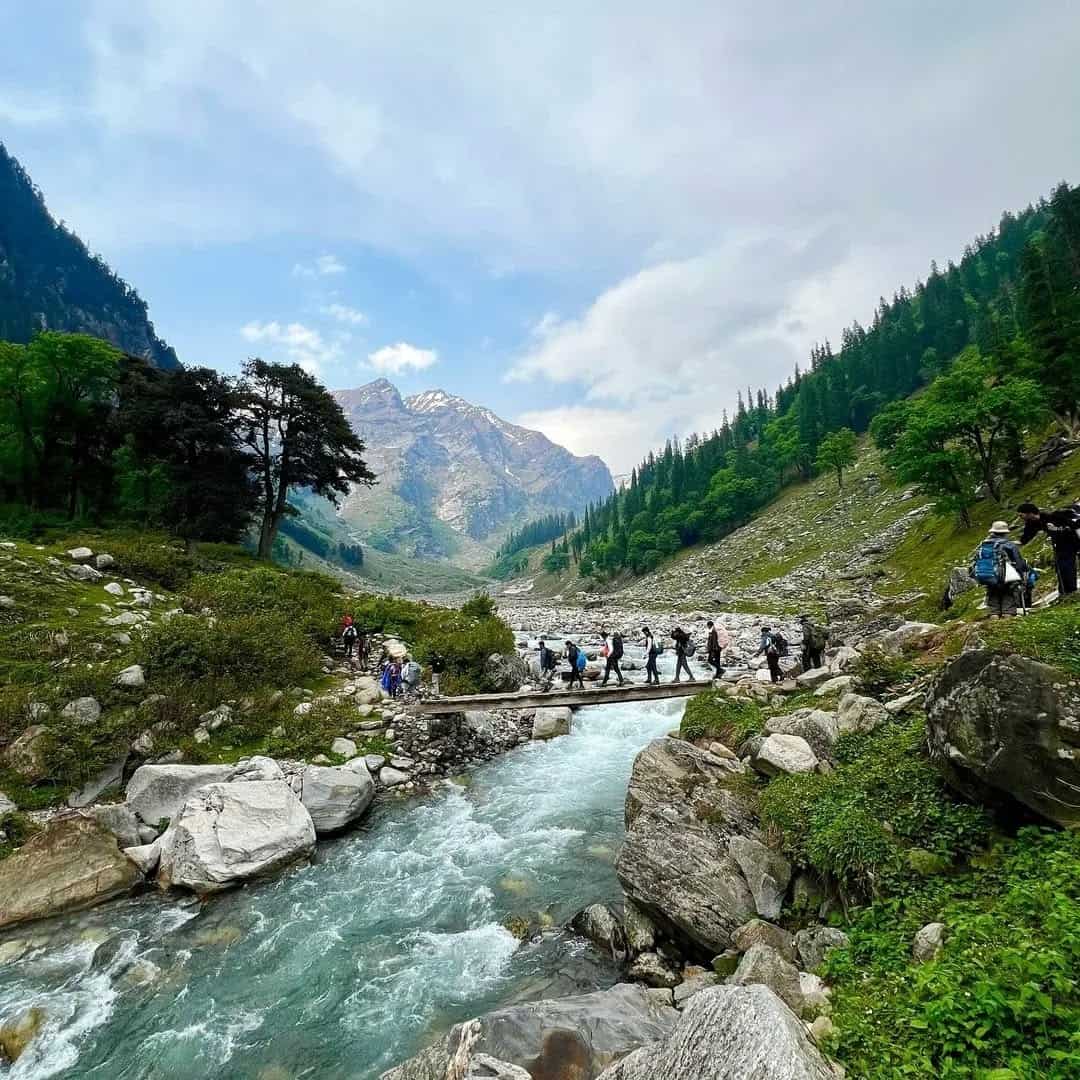Trek Grade
Easy to Moderate
Highest Altitude
14,100 ft
Base Camp
Pipalkoti
Best Time
July, August to mid Sept
Trek Distance
40 Km
Not sure which trek is right for you? Trekup India’s Mountain Experts have you covered.
Not sure which trek is right for you? Trekup India’s Mountain Experts have you covered. From figuring out if a trek matches your fitness level to knowing who you’ll be trekking with, we’re here to answer all your questions. Reach out to our Mountain Experts and plan your trek with confidence.
Valley Of Flowers Trek
The Valley of Flowers Trek is a popular and enchanting trekking location in the Garhwal Himalayas. It offers stunning views of colourful flowers, green pastures, and the snow-capped Himalayas. Situated at 14,100 ft. above sea level, the Valley of Flowers is a UNESCO World Heritage Site. It is mainly known for its gorgeous flowers in different colours and shapes. The trek is best experienced from June to September when the Valley is fully blooming. Visitors can also spot rare species such as blue sheep and red fox during the trek. The Valley is home to over 300 rare and endangered species of flowers, as well as Himalayan animals like blue sheep, black bears, and snow leopards. The trek is not easy, with moderate difficulty and long trekking days. The route includes a steep ascent to Hemkund Sahib, challenging trekkers’ endurance. However, the breathtaking scenery and abundant flora and fauna make it a must-visit destination for nature lovers and adventure enthusiasts. The Valley of Flowers trek is one of India’s most renowned treks, and it became a UNESCO World Heritage Site in 2002. While it’s a challenging trek, the enchanting beauty of the Valley makes it a top choice for trekkers seeking an unforgettable experience in the Himalayas.
Get ready to explore the astonishing sights of green surroundings, followed by the Himalayas’ gleaming snowy mountains. When it comes to the most fascinating and enthralling Valley in India, this trek is on top because it perfectly displays the abundance of colourful flowers and green pastures. You can find thousands of blue Primula blooming in this Valley, giving you a picture-perfect view. Primula is one of the most gorgeous and lovely Himalayan flowers. The best time to visit this Valley in full bloom is mid-July to mid-August. It would help if you trekked from Govind Ghat to reach the Valley of Flowers, and on the route, you will also pass from Hemkund Sahib. This Valley is about 5km from Ghangaria.
Trek offers a natural walk into the quintessence of flora and fauna. Not only this, but you can also find more than 300 rare and endangered species of flowers in this Valley. Some rare species include Primulas, Calendulas Daisies, Orchids, and Poppies. As you trek up toward the Valley, you can find some fantastic Himalayan animals, such as blue sheep, black bears, and snow leopards. The eye-catching Flora and Fauna make this location a perfect destination for trekking. If you are an adventure freak, you will fall in love with the mesmerizing view of the Valley. Make sure to keep your camera ready because the captivating scenery in this Valley is waiting for you. You need to know that the trek is not easy because the trekking level is moderate, and the trekking days are slightly longer. This trek will challenge your endurance because there is a steep ascent to Hemkund Sahib. So, prepare yourself accordingly for the trek.
When you stand at the entry of this Valley, you will see a mesmerizing carpet of colourful flowers ahead, leaving you speechless. Any enthusiast of the Himalayas thinking about a trek in Monsoon will keep this trek at the top of the list. Undeniably, this Valley is one of the liveliest and most tempting places you will come across in the West Himalayas. It is famous for its wide variety of flowers and alpine trees that perfectly add an enchanted feel to the Valley. The scenery is serene, and you will also come across fantastic nature views and waterfalls while trekking. If you love mountain landscapes and breathtaking natural views, you need to go for this trek at least once in your life.
The Valley of Flowers trek is 1 of India’s hottest treks in the Himalayas. Individuals not stepping into the Himalayas have learned about the Valley of Flowers trek. But there’s a good reason for Valley Of Flower’s renowned recognition – it’s 1 of India’s oldest known treks. In 1980, the Indian government made the Valley of Flowers National Park, and later on, in 2002, it was realized as a UNESCO World Heritage Site. This pushed Valley of Flowers on the bucket list of trekkers from near the planet. However, remember that the Valley Of Flowers trek isn’t simple. It’s a moderate fitness level trek, with somewhat more time trekking many days, along with a steep ascent to Hemkund Sahib designed to challenge your stamina. Thus, make nice for this particular trek. We’ve talked in detail about this trek.
Trek Cost
From Natraj Chowk – Rishikesh at 6:30 A.M. & will drop at the same location by 7-8 P.M.
Fix Departure Dates
Valley Of Flowers Trek Videos
Videos by experts watch these videos to prepare well for a Successful Trek
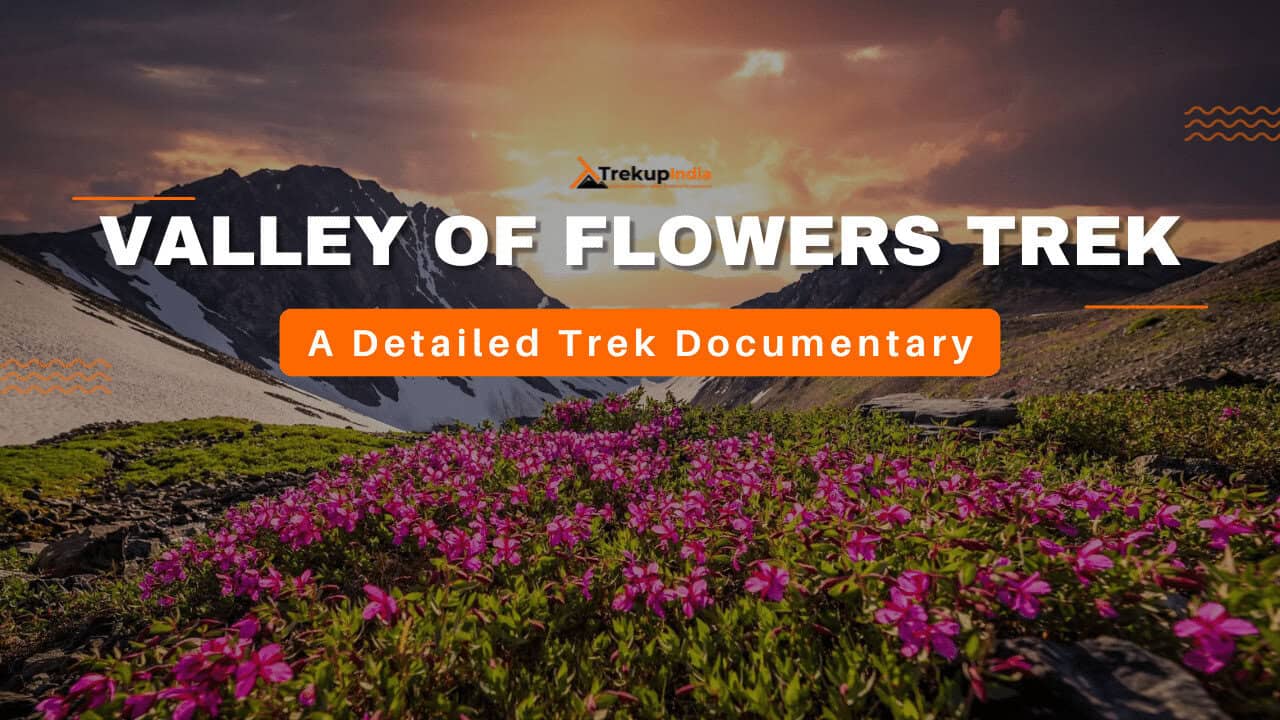
Want To Trek Like Pro?
Basically, watch these videos if you want to trek the same way professional trekkers do and make your skills better. These videos contain useful tips and techniques to further improve your trekking skills itself. These videos actually help both new and experienced trekkers improve their trekking skills. These videos definitely provide useful tips that make your trek better. We are seeing that these videos by Trekup India experts will only help you make your trekking skills better.







Know Everything About Acute Mountain Sickness
Acute Mountain Sickness occurs when people trek to high altitudes above 8,000 feet. This condition itself develops further due to reduced oxygen levels at such heights. Basically, as you go higher up, the air pressure and oxygen levels decrease, which causes the same problem. Acute Mountain Sickness surely causes headache, nausea, vomiting, and dizziness in affected persons. Moreover, peoples also experience difficulty in sleeping during this condition. To avoid mountain sickness, you should actually trek up slowly to higher altitudes. To learn further about this condition itself, watch the videos by Trekup India.



Day Wise Detailed Itinerary of Valley Of Flowers Trek
Day 1: Rishikesh to Pipalkoti (Drive)
- Altitude: 1900m/6,200ft
- Drive Distance: 275 Kms
- Drive Duration: 10-11 Hrs
- Altitude, 1900m/6,200ft; Joshimath is 275km from Rishikesh.
- You will be picked up sharp at 6:30 AM from Rishikesh.
- It is going to be a long drive of almost 10-11 hours, so get prepared accordingly.
- In Joshimath, you will get the last ATM point.
- You will also get a small market in Joshimath
- You will not face any networks problem all along the way
- Night stay will be scheduled in a guest house with shared accommodation
Driving Route
- From Rishikesh to Devprayag, where the Bhagirathi River and Alaknanda River meet.
- Continuing from Devprayag to Srinagar.
- Proceeding from Srinagar to Rudrapryag, where the Mandakini River and Alaknanda River converge.
- Finally, journeying from Rudrapryag to Karnprayag, where the Pindar River and Alaknanda River join together.
Your adventure with us commences in Rishikesh, from where we’ll embark on a scenic drive along the legendary Badrinath Road. The 9-hour journey to Pipalkoti may be lengthy, but the breathtaking vistas will ensure that you stay engaged and enthralled throughout. As we ascend, the majestic river flowing alongside us will become increasingly turbulent and captivating.
We’ll pass through 4 of the 5 sacred confluences of Ganga—Devaprayag, Rudraprayag, Karnaprayag, and Nandaprayag—offering ample opportunities for photography and unforgettable experiences. So, keep your eyes peeled and your cameras ready to capture the beauty of this divine journey.
Day 2: Pipalkoti to Govindghat-Pulna and trek to Ghangharia
- Altitude: 2,000m/6,800ft
- Drive Distance: 40 Kms
- Drive Duration: 4 Hrs
- Trek Distance: 9 Kms
- Trek Duration: 4 Hrs
- 40km drive from Govindghat to Pulna which is located at a height of 2,000m/6,800ft. The drive will be of 4 hours.
- Trekking for 9kms from Pulna to reach Ghangharia which is situated at an altitude of 2,290m/9,800 ft. You will reach in 4 hours Ghangharia.
- You will trek on a gradual ascent on a stone-paved path along with the river.
- Water is available all along the route so you can refill your water bottles easily.
- Trekkers will be served with packed lunch
- From Pulna, Mule and porter facility is available
- BSNL network will be available only at Ghangaria
- Helicopter service is also available from Govind Ghat to Ghangaria if the weather is good (this cost is not included)
- Night stay in the guest house
- You will also come across some of the amazing sites such as Govind Dham Gurudwara, Govindghat, Hemkund Gurudwara base, Information Center.
Govindghat is almost 22km from Joshimath. We’ll begin our journey after breakfast and reach Govindghat by 8 am, followed by a 4 km drive to Pulna, which serves as the starting point. Today’s travel is included in the cost. The 9 km uphill route runs parallel to the river Pushpawati and is usually bustling with people. Don’t worry about going hungry, as there are plenty of snack shops selling beverages, hot noodles, omelets with bread, paratha, and other snacks throughout the trail.
You will follow a well-marked path made of stone and stairs during the hike. Once you have walked 5 km, you will reach the village of Bhyundar, which offers a stunning view of Hathi Parvat. Take your time to appreciate the sight, as the challenging uphill climb will begin afterward. By nightfall, you will reach Gangharia, reaching an elevation of 10,000 feet. Accommodation will be provided at a guest house.
Day 3: Ghangaria to Valley of Flower and back to Ghangaria
- Altitude- 3,500m/11,500ft.
- Trek Distance: 6-7 Kms
- Trek Duration: 7 Hrs
- Distance- Each way it’s 4km.
- Be prepared, as you will be trekking for 7 long hours.
- The valley is almost 6-7km long and ends with a glacier.
- Till the valley, you will find mixed gradient along with level walk on grassland
- On the way, you will come across several streams that are perfect for refilling your water bottles.
- Packed lunch will be served as no food is available in the valley
- Before the sunset, we will return back to Ghangaria as camping is not allowed inside the valley
- A night stay will be scheduled in a guest house.
- In the valley, you will come across beautiful & unique flowers like white leaf hog foot, blue poppy, Himalayan rose, snake foil, dog flower, river anemone, meadow geranium, and hooked stick seed.
Get up early in the morning and have your breakfast till 07:00 AM. Day 3 is going to be quite exciting as we will be trekking from Ghangaria to Valley of Flower and then back to Ghangaria. This day will definitely refill your memories with some amazing & lasting views of dreamland. The trek to Valley will help you to experience the solace of nature without the hustle & bustle of city life because this valley is a true beauty as well as the paradise of nature.
The journey to the trek from Ghangaria is almost 4km. The valley is 6-7km long and the distance traveled in the valley is going to depend upon how the trekkers want to explore the valley. However, it is also going to depend upon the stamina of trekkers. After 30 minutes, when you start from Ghangaria, the forest check post will arrive. Although, you might not find the check post interesting but just before this check post there is a gushing waterfall known as the Laxman waterfall. The next attraction will arrive, after trekking for 20 minutes in the greenery.
This is the point where you will find the Pushpavati river flowing below the wooden bridge, giving a perfect example of beauty. Though it is common but still something unique and mesmerizing to capture in your camera. The trail is steep and stone-paved just like the before days. As you enter inside the valley, you will find several bridges and landslide areas.
Right after entering the valley, you can hear the melody chirping sounds of the birds as well as flowing water. The perfect natural beauty offered at this trek is different and takes you to another world. The valley is going to offer you amazing experiences and beautiful views that are just beyond your expectations. The views of Himalayan peaks are quite relishing and sparkling that you cannot miss.
You will also find some native flowers at Valley of Flowers trek like blue poppy, hooked stick seed, White leaf, meadow geranium, hog foot, Himalayan rose as well as dog flower. After a 5 km stretch at a glacier, all these eye-catchy colorful blossoms will come to an end. In order to make the trek more pleasurable and unforgettable, you can quickly wind up and reach the Pushpavati River because this is something you cannot afford to miss. Near this river, you can find breathtaking views of nature and even relax in the lap of nature.
If you are lucky enough and the weather is good then you can also enjoy famous Himalayan peaks such as Gauri Parvat, Nilgiri Parvat, Rattaban, Bhyundar Khal, and several others. Before the sunset, we will be trekking back to Ghangaria and enjoy lip-smacking dinner.
Day 4- Ghangaria to Hemkund Sahib and back to Ghangaria
- Altitude: 4,300m/14,100ft
- Trek Distance: 5.5 Kms
- Trek Duration: 7 Hrs
- Located at an altitude of 4,300m/14,100ft.
- The distance is 5.5km each way; it is going to be a 7-hour-long trek.
- The trek path has a gradual and steep mixed ascent.
- Till Hemkund Sahib, a mule ride service is available.
- From road side dhabas, you can easily refill your water bottles.
- You will be served with hot lunch at Gurudwara langar.
- On the way to Hemkund Sahib, you can find Himalayan blue poppy; Brahma Kamal.
- A night stay will be scheduled in the guest house at Ghangaria.
Early in the morning, we will start our trekking after having breakfast in order to visit the famous holy shrine of Hemkund Sahib. It is located at a height which is alpine as well as above tree line. The track is quite wide and also well-defined because several pilgrims from across the globe visit Hemkund Sahib in order to seek blessings.
While trekking from Ghangaria to Hemkund Sahib, you can find several tea stalls as well as Dhaba. Around this trail, while approaching the height of 4000m, you will find that Brahma Kamal blooms in plenty. With a moderate incline, the climb is continuous. It is going to take almost 3 to 4 hours for reaching Hemkund Sahib. You need to know that The Hemkund Sahib is one of the most valuable shrines for every Sikh and is also considered the world’s highest gurudwara which is located at an altitude of 4,329 meters.
The lake is definitely a treat for your eyes that remains misty in the monsoon season. Don’t forget to spend some quality time around the lake and enjoy a cup of tea which is specially served by the Gurudwara committee.; This place is located between the snow-clad mountains as well as a beautiful serene lake that offers a mesmerizing view of the mystical location.
At the time of clear skies, you can also observe perfect imprints of the butting Saptrishi tops. This lake is mainly taken care of by dissolving ice masses of Saptrishi tops as well as Hathi Parvat. Not only this, but you can also find a strict Laxman sanctuary close to the lake. It is important for you to know that the area surrounding the lake is so enthralling that it will definitely blow away your mind with its picturesque attractiveness and fascinating sights of beautiful flowers such as Brahmakamal, blue poppy as well as Vajardanti.
Since the weather can turn bad at any time, so by the evening, we will be returning back to Ghangaria & where you will be served hot and delicious food. A night stay will also be scheduled here. Get ready to enjoy the impeccable experience and collect some unforgettable memories along with you.
Day 5- Ghangaria to Govindghat and Drive back to Pipalkoti (Badrinath optional)
- Trek Distance: 13 Kms
- Trek Duration: 5 Hrs
- The trekking distance from Ghangaria to Govindghat is 13km which will take a 5-hour time.
- It is just a 20-minute drive from Govindghat to Joshimath.
- All the trekkers will be served with hot and delicious packed lunch on the way.
- A night stay will be scheduled in the guest house at Joshimath.
Note: You need to know that during the Monsoon time, Govind Ghat to Badrinath is a landslide prone area. So, if our leaders will find that your safety is at risk because of the bad weather condition, landslides, or road blockage then we will not drive to Badrinath and drive directly to Pipalkoti.
After having your breakfast in the morning, you start descending to Govindghat and then finally drive back to Joshimath. From here, Badrinath is almost 25km which will take 1 hour to reach. If the weather and road are good then we will also visit Badrinath. On day 5, the trek will move in the reverse direction i.e., from Ghangaria to Govindghat. The trek is easy and offers you a perfect view of nature that you might not have even expected. After reaching Govindghat, we will head towards Badrinath only if the weather and road are good. The journey to Badrinath is really amazing because it offers a lovely view of waterfalls as well as a gorgeous river.
Note: You need to know that Govindghat to Badrinath is a landslide prone area at the time of monsoon. So, if our trek leaders find that the safety of trekkers is at risk because of the bad weather condition or monsoon then we will directly drive back to Pipalkoti. You will be reaching Pipalkoti by evening or night and then a night stay will be scheduled in a guest house.
Day 6:- Pipalkoti to Rishikesh
- After having tea or coffee, we will depart to Rishikesh from Pipalkoti.
- You will be reaching Rishikesh in the evening around 6 to 7 PM.
- Get your bookings and tickets done accordingly.
- You can also do the tickets for your hometown after 8:30 PM
This is the last day of the trip so make sure to make the most of it. We will drive back to Rishikesh early in the morning by 6 AM so that we can reach by 6-7 PM. Breakfast and lunch on the way by your own expences.
All the trekkers can get their bookings done for their hometown accordingly after 8.30 PM.
Valley Of Flowers Trek Route Map
We’ve prepared a comprehensive Trek Route Map for your upcoming adventure to Valley Of Flowers Trek, which outlines the entire journey including all stops and trails. This map provides detailed information on the terrain, distance between points of interest, and estimated travel time to help ensure a safe and enjoyable trek. We’ve carefully curated the map to ensure that you have all the necessary information at your fingertips. Please take a moment to review it thoroughly, and don’t hesitate to reach out if you have any questions or concerns.
Valley Of Flowers Trek Altitude Chart
The Valley Of Flowers Trek Altitude Chart Altitude Chart is a useful tool for Trekkers to monitor their altitude changes during their rides, allowing them to plan their routes more efficiently and track their progress over time. This Valley Of Flowers Trek chart is beneficial for both casual and experienced Trekkers, helping them make the most out of their Trek experience.
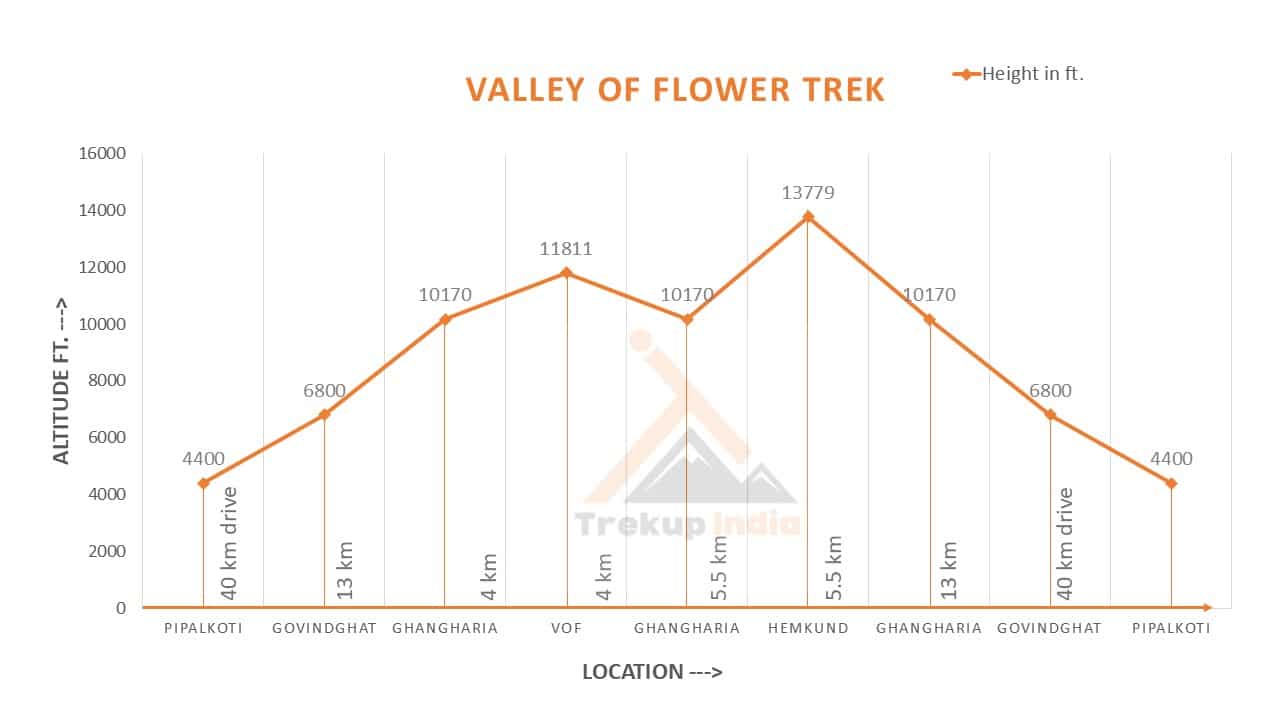
Trek Cost Inclusions
- Stay: 5 Nights of Hotel & Guest House accommodation on multi-sharing.
- Meals: Trekup India will provide freshly cooked meals during the trek starting with Dinner on Day 1 to Tea, cooffe on day 6 (Meals are simple, nutritious, and vegetarian)
- Transport (Optional): From Rishikesh & Return. ( 1600 extra )
- Trek Insurance (Optional): Trekup India recommends that all trekkers consider getting trek insurance. This is optional, but highly recommended. Trek insurance covers unexpected events that may occur during your trek. The cost of the insurance starts from INR 210. Please read more about what is included in the coverage and why it is mandatory on treks.
- Trek Equipment: Kitchen tent, Dining tent.
- Amenities: All utensils, sleeping mattresses (Black foam mats), Crampons, and Gaiters for snow.
- Health & Safety: First Aid Box, Oxygen Cylinders, Stretchers, Oxi meters, BP Machines, health.
- Permits: Forest Permits and Camping Permission Fee
- Trek Crew: High Altitude Chef, Helpers, Trek Leader & Guides, and other support teams.
- Potters & Mules: Potters and Mules are to carry all trekking equipment, ration, and vegetables.
Trek Cost Exclusions
- GST 5% (it is Mandatory)
- Any Meals/accommodation beside the itinerary or not mentioned in the program.
- Trekkers are responsible for covering any extra expenses resulting from landslides before or after the trek.
- Any Bus / Airfare to/from trek start/end point
- Personal Medical expenses do carry your medication.
- Any personal services such as Laundry, phone calls, liquors, mineral water, etc.
- Any still / video camera fee
- Any Entrance fee Monuments, Monasteries, Museums, Temples – Pay directly on the spot.
- Mules or porter charges to carry private baggage (Offload Charges for bag 1680 for entire trek if paid online (at base camp 2,550). Note: Bag weight should not be more than 10 kg.
- Any emergency evacuation charges
- Any services that are not mentioned in the cost inclusion section.
What should you pack for the Valley Of Flowers Trek
Valley Of Flowers Trek is a high-altitude trek. The trekking gear you have to have for this particular trek differs from normal treks. Thus, read this whole segment. There is an important question that the trekker who is doing trek asks, like what all things to carry while trekking. Below, we have provided the details on everything you should take; an easy way to remember is by Head to foot or foot to head. We have prepared from Head to foot.

Head Gears
When trekking it's important to carry headgear to protect your head and face.
Heading out for a trek? Don’t forget to carry headgear to protect your beautiful face and head from the sun, wind, and dust! It’s an essential accessory that keeps you safe and comfortable throughout your adventurous journey. So, make sure you pack it before you step out into nature!
- Head Lamps – When trekking at night, headlamps are essential to illuminate your path while keeping your hands free. Headlamps come in different sizes and lumens, so it is essential to choose one that suits your needs.
- Hats or Cap – Caps or hats are also necessary when trekking in different weather conditions. Caps protect your head from the wind and freezing temperatures at night, while hats provide shade and protection from the sun during the day. It’s essential to ensure that your hat has a strap to prevent it from being blown away by the wind.
- Sunglasses – Sunglasses are also essential for trekking. Your sunglasses should protect your eyes from harmful UV rays and fit your face perfectly to avoid falling off while climbing, jumping, or crossing obstacles. The glass of your sunglasses should also be designed for different weather conditions to provide optimal visibility.
- Buff / Balaclava – Lastly, a buff or balaclava is a must-have to protect your mouth or neck from extreme temperatures and keep them warm. Buffs and balaclavas come in different materials, thicknesses, and designs, so it’s important to choose one that suits your needs and preferences. Depending on the weather conditions and your activities, you can wear them as neck warmers, face masks, or headbands.
Clothes
When trekking in high altitudes, prepare for cold weather by wearing layers. Layering traps heat, keeps you warm, and allows you to easily adjust your clothing as temperatures fluctuate.
Layering is important for different seasons when trekking. When planning a high-altitude trek, it is important to prepare for the cold weather. Wearing layers is the best approach as it provides both protection and flexibility when the weather changes frequently in the mountains. Layering helps to trap heat and keep your body warm, while at the same time allowing you to easily adjust your clothing as the temperature fluctuates. By wearing layers, you can enjoy your trek comfortably and stay safe in the unpredictable mountain weather
- For spring, summer, and monsoon treks, consider wearing three layers: a woollen sweater, a fleece, and a padded jacket.
- For autumn treks, add one more fleece layer to make it four layers.
- For winter treks, you may need five layers with thermals, a woollen sweater, two fleeces, and a padded jacket.
- T-shirt/sleeve shirt– Bring three T-shirts and two quick-dry trek pants, wearing one and carrying the others. Long sleeve shirts help to protect from sun UV rays. We recommend synthetic T-shirts as they get dry quickly when they get wet.
- Hiking / Trekking Jacket– down jackets (-5 to-10 C) or two-three-layer jackets.
- Thermals– at least two pairs of thermals help keep the body warm during cold weather.
- Undergarments– you can carry them according to your habitual and hygiene requirements.
- Gloves– 1 pair of gloves will keep your hand warm and nice.
- Trek Pants– Bring 2 to 3 comfortable trekking pants. Trekking pants play a significant role, as they are designed for comfort and mobility, making trekking easier. It should be Synthetic so that it gets dry quickly when wet.
- Rain Wear– you can carry a raincoat or Poncho. During long rains and snowfalls, the waterproof jackets start leaking. Still, the Poncho and raincoats keep you dry, so choose accordingly.
Tip: If you choose a raincoat on your trek, carry a small waterproof cover so things inside your backpack can’t get wet. If you carry a Poncho, you don’t need to worry. It protects both you and your backpack.
Foot Gears
When it comes to planning a trek, one of the most important aspects is to ensure that you have the right kind of foot gear.
- Trekking shoes which are waterproof and have ankle support. Walking / Hiking sandals which can be used off the trek, i.e., in the morning and evening hours when you reach the campsite, basically to get your feet rest from heavy boots, sometimes used for crossing streams and rivers, it’s more comfortable and safer than crossing barefoot or wetting your shoes. Sneakers (Optional) can be worn for normal driving days or used around the camp.
- Socks– you should at least carry 3 to 4 pairs.
- Microspikes & Gaitorswill be provided by Trekup India when required. You don’t have to carry them.
Personal First Aid Kit
Don't forget to pack your personal first aid kit! It's always better to be safe. So, make sure you're prepared for any unforeseen circumstances.
Below are some common medicines generally required/used during your adventure trip; however, please consult your doctors prior.
- Antiseptic towel or water syringe (to clean the wound)
- Butterfly bandage for a small cut
- Cotton and elastic bandages and sterile gauze pad for larger wounds
- Latex gloves are used when the wound bleeds.
- Medicine for Diarrhea (Upset stomach)
- Medicine for cold, flue/fever, headache
- Some pain killers
- ORS pouches
- Quick pain relief spray (External use)
- Any personal medicine prescribed by your doctor
- Dimox / Similar for high altitude sickness
- Bug Repellent
- Carry some nutria/energy bars and drinks (non-alcoholic)
- Note: Kindly consult your doctor before purchasing or taking any medicine.
Gadgets and Other Items
You might also consider bringing a camera, binoculars, portable charger, and snacks. Be well-prepared and tackle any trail with confidence.
- Trekking Poles
- Mobile phone
- Camera
- Spare batteries for phone and camera, power bank
- Lightweight flashlight or headlight
- A waterproof bag made of plastic is used for the camera.
- Plug/converter for electrical items
- 1-litre water bottle
- A journal with a pen would be a good idea to keep your notes.
- Some book of your interest for the ideal time
- Get into the habit of maintaining a Map and guidebook of the region.
Hygiene & Personal toiletry
Remember to pack hygiene and personal toiletry items such as soap, shampoo, toothbrush, toothpaste, deodorant, and toilet paper.
- Sunscreen with UV protection to shield your skin from harmful rays
- 1 or 2 small quick-drying towels to help you dry off quickly in case of rain or sweat
- Toilet paper, tissues or wet wipes for maintaining hygiene while on the trek
- Toothbrush, toothpaste, and mouth freshener to keep your mouth clean and fresh throughout the journey
- Deodorant or talcum powder to help you stay fresh and odor-free, especially during hot and humid climates
- Shampoo to keep your hair clean and healthy
- Sanitary pads or tampons (for female trekkers) to manage menstrual cycles
- Lip-gloss or salve to protect your lips from dryness and chapping
- Bio-degradable soap to keep yourself clean and hygienic while on the trek
- Nail clipper and other personal items that you use daily
Compulsory Documents to Carry
There are certain documents that you should always carry with you. These documents are not only necessary for your safety and security, but they may also be required by local authorities.
These files must be submitted to the Forest Department before your trek. With none of these, you will not be permitted to trek—original and photocopy of government photo identity card. Carry IDs like Aadhaar, voter ID, etc.
How To Plan Your Trek & Reach Rishikesh
By Air: Jolly Grant Airport, a mere 25km away from Rishikesh, is the most convenient airport for your journey. Regular flights from Delhi to Rishikesh are readily available, ensuring a smooth travel experience.
For those considering a flight to Rishikesh, it’s highly recommended to plan your arrival a day in advance. This foresight allows for any unforeseen delays or changes in your schedule, ensuring a stress-free start to your Rishikesh adventure.
By Train: If you’re opting for a train journey, your route will take you to Haridwar first. From there, a bus ride of approximately 35 km will bring you to Rishikesh, your final destination.
By Bus: From Delhi, a reliable and frequent bus service is available for Rishikesh. ISBT Kashmere Gate, the central bus station in Delhi, offers both AC and non-AC buses for Rishikesh. Opting for government buses from Kashmere Gate ISBT is always a sound choice. The bus will drop you off at Rishikesh ISBT, where our staff will be ready to pick you up, ensuring a hassle-free journey.
Rest assured, at 06:30 am, a Bolero, Tata Sumo, or a similar vehicle will be waiting to pick you up from Rishikesh, ensuring a timely and comfortable transfer.
By 04:00 pm, you will be reaching Pipalkoti.
Fitness Required & Preparation Guide Valley of Flowers Trek
If you’re preparing for a Valley of Flowers Trek, Trekup India recommends jogging as part of your fitness routine. Jogging helps work out the same muscle groups that you’ll use during trekking and can help you build endurance. You don’t need any special equipment to get started.

Fitness Target
Trekup India has put the Valley of Flowers Trek into an easy-to-moderate-grade-level trek.
For Easy – Moderate Treks – In order to be well-prepared for your upcoming trek, it is recommended that you focus on building your endurance by aiming to cover a distance of 4.5 kilometers in less than 45 minutes. This will help you to develop the necessary stamina and strength required to successfully complete your journey.
How to Achieve This Fitness Target?
To start preparing for your trek:
- Try jogging for at least five days every week.
- If you find 5 km too difficult at first, begin with 2 km and gradually increase over 2-3 weeks.
- Once you feel more comfortable running 5 km, focus on improving your speed gradually on a daily basis.
It is important to ensure that you can consistently complete 4.5 km in under 40 minutes for at least two weeks before your planned trek. Allow yourself 6-8 weeks to prepare physically for the journey.
Strength Training exercises that benefit Trekking
Trekking is an activity that demands a good level of strength.

Trekking is a demanding activity that requires good cardiovascular endurance, muscular strength, and overall fitness. To help you prepare for your trek, incorporating bodyweight exercises into your training routine can be an effective way to build strength, improve stability, and enhance endurance, all of which are crucial for a successful trek. In this regard, here’s a breakdown of body weight exercises categorized by the specific body parts they target and the benefits they offer during trekking.
1. Lower Body Exercises
Lower body exercises like squats and lunges are great for building lower body strength, essential for trekking.
a. Squats
Squats are an excellent exercise for building lower body strength, essential for trekking. They target the quadriceps, hamstrings, glutes, and calves. Solid quadriceps and glutes provide power for ascending and tackling uphill climbs, while vital hamstrings aid stability during descents. This is particularly helpful in navigating uneven terrain during trekking.
How to perform Squats Exercises:
- Stand with feet shoulder-width apart, toes pointing slightly outward.
- Lower your body by bending your knees and hips, keeping your back straight.
- Lower until your thighs are parallel to the ground or as low as comfortable.
- Push through your heels to return to the starting position.
b. Lunges
Lunges target the quadriceps, hamstrings, glutes, and calves. They improve lower body strength, balance, and stability, crucial for maintaining control on rocky trails and steep slopes. Additionally, they enhance flexibility, reducing the risk of injury while trekking.
How to Perform Lunge Exercises:
- Stand with feet hip-width apart, hands on hips or sides.
- Take a step forward with one foot, lowering your body until both knees are bent at 90-degree angles.
- Push through the heel of your front foot to return to the starting position.
- Repeat on the other side, alternating legs.
2. Upper Body Exercises
Upper body exercises such as push-ups and pull-ups effectively strengthen the upper body, especially the chest and shoulders, which are essential for carrying a backpack during treks.
a. Push-Ups
Targets: Chest, shoulders, triceps, and core.
Benefits for Trekking: Push-ups are an effective exercise to strengthen the upper body, especially the chest and shoulders, essential for carrying a backpack during treks. Improved upper body strength will also help maintain posture and stability while traversing challenging terrain.
How to Perform Push-Ups Exercises:
- Start in a plank position with hands shoulder-width apart and body in a straight line from head to heels.
- Lower your body by bending your elbows until your chest nearly touches the ground.
- Push through your palms to return to the starting position.
- Keep your core engaged throughout the movement.
b. Pull-Ups/Bodyweight Rows:
Targeting the back, biceps, and shoulders can significantly benefit trekking. You can strengthen these muscle groups by performing pull-ups or bodyweight rows and improve your posture and balance while carrying a backpack. Additionally, more muscular back muscles can help reduce the risk of back strain and fatigue during long treks, making your journey safer and more comfortable.
3. Core Exercises
Core exercises like planks and Russian twists can help strengthen the core muscles, which are crucial for maintaining stability and balance while trekking on uneven terrain.
a. Planks
Targets: Abdominals, obliques, and lower back.
Benefits for Trekking: Planks are an effective exercise that helps strengthen the core muscles. These muscles are crucial for maintaining stability and balance while trekking on uneven terrain. A strong core also helps improve posture, reducing the risk of back pain and fatigue during extended hikes.
How to Perform Planks Exercises:
- Start in a plank position with elbows directly under shoulders and body in a straight line from head to heels.
- Engage your core and hold the position, avoiding sagging or arching the back.
- Keep breathing steadily and hold for the desired duration.
b. Russian Twists
Targets: Obliques, abdominals, and lower back.
Benefits for Trekking: Russian twists engage the core muscles, particularly the obliques, improving rotational stability and balance. Enhanced core strength helps prevent injuries and improves overall performance during trekking.
How to Perform Russian Twist Exercises:
- Sit on the ground with knees bent and feet flat, leaning back slightly to engage the core.
- Clasp hands together and twist the torso to one side, bringing the hands towards the ground beside the hip.
- Return to the centre, then twist to the other side.
- Continue alternating sides for the desired number of repetitions.
4. Full Body/Cardiovascular Exercises
Full-body/cardiovascular exercises like burpees and mountain climbers are excellent for improving cardiovascular endurance, strength, and agility.
a.Burpees
Burpees are an excellent full-body exercise that targets your legs, chest, arms, and core. This exercise dramatically benefits trekking enthusiasts, improving cardiovascular endurance, strength, and agility. Regularly incorporating burpees into your workout routine can enhance your overall fitness level, which can help you endure long hikes and rugged terrains with ease.
How to Perform Burpees Exercises:
- Start in a standing position.
- Squat down and place hands on the ground.
- Jump feet back into a plank position.
- Perform a push-up.
- Jump feet back to the squat position.
- Explosively jump up into the air, reaching overhead.
- Land softly and repeat the sequence.
b. Mountain Climbers
Mountain climbers target the core, shoulders, chest, and legs. This dynamic, full-body exercise can significantly improve cardiovascular endurance and agility. It is an excellent functional workout for trekking preparation as it engages both the upper and lower body muscles while strengthening the core muscles.
How to Perform Mountain Climbers Exercises:
- Start in a plank position with hands shoulder-width apart and body in a straight line from head to heels.
- Drive one knee towards the chest, then quickly switch legs, alternating in a running motion.
- Keep the core engaged and the hips stable throughout the movement.
- Continue at a moderate to fast pace for the desired duration.
Incorporating bodyweight exercises into your training routine can help you build strength and endurance and prepare your body for the physical demands of trekking. Consistency and proper form are crucial to maximizing the benefits of these exercises and ensuring a safe and enjoyable trekking experience. Engaging your core muscles, including obliques, abdominals, and lower back, with Russian twists can improve your rotational stability and balance, preventing injuries and enhancing overall performance during trekking.
When incorporating strength training exercises into your workout routine, it’s essential to maintain proper form and technique to avoid injury. Start with lighter weights and gradually increase the intensity as you progress, focusing on compound exercises targeting multiple muscle groups simultaneously. Some examples of practical strength training exercises for trekking include squats, lunges, deadlifts, and pull-ups.
Remember to give your muscles time to recover between workouts, and remember to stretch before and after your workouts to prevent injury and improve flexibility. Combining strength training with jogging and proper stretching allows you to take your fitness to the next level and confidently tackle even the most challenging treks.
Our Trekkers Reviews And Expreinces





We provide only Indian vegetarian food, and your meal will mainly consist of Indian bread, vegetables, lentils, rice, and a delicious dessert. During your trek, we will serve three meals a day, including breakfast, lunch, and dinner. You will also be served tea, snacks, and lip-smacking soup in the evening before dinner. If it is a long day of trekking, you will be given a packed snack.
After extensive research on the trekkers’ nutritional requirements, we prepare the menu. Before putting all the meals together, we also consider the altitude and the weather.
The meal we serve during the trek is perfectly balanced with calories, carbohydrates, vitamins, protein, fibre, and minerals. You need to know that all our cooks have great expertise in cooking and have undergone thorough training. So, get ready to enjoy delectable and lip-smacking dishes during your trek. You will be served with lemon tea in the tent to start your day with a refreshed feeling. Before leaving the campsite for trekking, you will be given a hot finger-licking breakfast like upma, Aallu Prantha, Besan Chilla, Poha, Daliya, Corn flakes, and Maggie, along with tea or coffee.
If your trek is longer, we also offer some fresh local fruits such as apples and healthy drinks like Frootie or Maaza. In the afternoon, you will be served a simple & healthy lunch, while at around 04:00 pm, you will be given tea and a light evening breakfast. After you reach your campsite at night, you will be served a hot and delightful dinner.
After reading this, you must have understood the food we provided on the trek; you don’t need to worry about food. Many trekkers repeatedly trek with us because of the food we provide. Thus, we will give you unforgettable experiences.

Trekking with us for the Valley of Flowers Trek is entirely safe because we have a team of trek leaders qualified in Wilderness first-aid and complete information about the high-altitude glitches. During the trek, we carry a full first-aid kit that contains all the essential medicines. Before trekking with us, you must ensure that you are medically fit for the trek; for us, your medical fitness is more important than anything else.
Right from our establishment, we at Trekup India have been continuously introducing new safety practices into Indian trekking to ensure the safety of voyagers. Trekup India introduced microspikes and made emergency bottled oxygen mandatory for all treks. Our trek leaders take your daily Pulse oximeter reading. We at Trekup India introduced the radio walkie-talkie as a safety communication device.
How can we ensure that your trek is safe with us?
We have noticed that most trek-organizing organizations do not follow these systems, but with time, they are following us; several competing companies are adopting these practices and organizing great, safe treks.
We ensure complete technical safety in the mountain. Our company has a vast team of more than 100 guides and trek leaders who serve on Himalayan treks. One of the best things about our team is that all the members are trained professionally by the Nehru Institute of Mountaineering, Indian Mountaineering Foundation Delhi, and Hanifle Center Outdoor Education Mussoorie.
Explore our New Safety Protocols
To ensure a perfect Trek, we have introduced some new safety checks to ensure excellent safety for our trekkers.
Our On-trek safety checks include:
- Daily oxygen saturation, along with pulse readings
- Stretchers team appointed on every trek
- Radios
- Trained mountain staff and complete safety
- Additional oxygen cylinders
- Special medical kit for high-altitude treks
- Microspikes on all types of snow treks
- Experienced Trek leaders, as well as safety
- Technical team on all snowy slopes
For Us, Your Safety Is the Top Priority
At Trekup India, you will find a team with local knowledge and fluency in English and Hindi. This helps ensure that you have a fantastic trek. Not only this, but we also pay attention to your health and safety because this is something we cannot ignore. All the team leaders involved in trekking have already undergone several professional courses in first aid, portable altitude chamber training, CPR, environmental awareness training, and advanced wilderness emergency medicine.
We also carry a complete first aid medical kit on every trek and trip we organize. Apart from the medical kit, we take a portable altitude chamber (if needed) and medical oxygen for all high-altitude treks. Our company has significant expertise in organizing all sorts of group adventure holidays for family groups, school and college groups, and friend groups. We have many travel options that suit different fitness levels and travelling styles.
Regardless of the group size, we value each and every member of our trekking groups. Our commitment to personal attention ensures that your needs and safety are always our top priority.
Who we are?
Trekup India has been a stalwart in the Adventure Tourism industry for 30 years. Since our inception, we have been dedicated to providing top-notch treks, voyages, trekking programs, and high-altitude expeditions. Our extensive experience is a testament to our commitment to your adventure and safety.
We organize treks in Uttarakhand, Kashmir, Sikkim, and Himachal while being part of the trekking community; we feature more than 75 documented Himalayan treks. In addition to other outdoor activities, our company also organizes trips for schools, colleges, and families.
Therefore, we maintain the quality of services offered to our valuable customers.
Must Read These Information Of Valley of Flowers Trek
Why You Should Do Valley of Flowers Trek
The Valley of Flowers
What sets the Valley of Flowers trek apart is its unique charm. The valley, a few kilometres wide and over ten kilometres long, welcomes you with a vibrant carpet of flowers in every hue imaginable. It’s a sight that stays with you, a memory that you cherish long after the trek is over.
A narrow path through the flowers invites you to go deeper. You start to see a variety of flowers, not just in colours but also in shapes, smells, textures, and sizes. After a few steps, you encounter an entirely new set of flowers. It was fascinating to observe the changing fauna along with the changing flora.
The Climb of the Trek and Hemkund Sahib
The Valley Of Flowers trek is a Easy to moderate level trek, but the climb to Hemkund Sahib is a true test of endurance. Over a distance of six kilometres, you ascend nearly 4,000 feet. It’s a challenging feat, but the reward is a breathtaking view that surpasses all expectations.
You will enjoy entering the alpine zone while going up to Hemkund. On the way up, you almost get a drone or helicopter view of the Valley and Ghangaia of flowers. You can see where you came from and where you went the previous day. A bird’ s-eye view adds a lot of perspective to the landscape scenery.
As you ascend steeply, you experience mixed experiences: leaving the treeline, entering alpine meadows, feeling the thin air, and looking up at the sheer alpine cliffs.
Once at Hemkund Sahib, the tranquillity of the lake and the surrounding mountains amaze you. The magnificent lake, reflecting its surroundings—the Gurudwara and the hills—makes you feel grateful for your entire journey. For many, it’s a peaceful reflection of their lives.
The Cultural Experience
The Valley Of Flowers trek is not just about the natural beauty. It’s a journey that tells a story of faith and determination. You’ll encounter people of all ages, from children to the elderly, making the arduous climb to the lake at 14,000 feet. It’s a testament to the human spirit and a cultural experience that leaves a lasting impression.
It was heartwarming to see volunteers sweeping every part of the trail to keep it clean and working at Hemkund Sahib Gurdwara in snowy conditions. It was a great experience to wake up in Ghangria at dawn to the calls of the Sikh Gurudwara. The trek reveals a world you would hardly notice otherwise.
Why Valley of Flowers Trek is Must?
- The trek is a must-visit place for trekkers because it offers an amazing trekking experience that is not possible on any other trek. Here are some top reasons why you should go on this trek at least once in your life.
- You will experience a picturesque place where nature blooms with its complete view. The stunning sights of cascading waterfalls, flowery meadows, and small streams are a treat for your eyes.
- If your hectic life schedule has taken a toll on you, trek to the Valley and spend some quality time in nature to rejuvenate yourself. If you love solitude, this Valley will offer you much space.
- The gentle chirping of the birds, the uplifting air, the amazing aroma of flowers, and the eye-catching views of nature will make your trek memorable.
- Your trek is incomplete without visiting the Hemkund Sahib Gurudwara, considered the holiest place of worship for Sikhs. The gurudwara’s calm and peace, along with the mouth-watering Prasad, is sure to soothe all your tiredness. In Uttarakhand, Hemkund is considered one of the loveliest lakes.
- The stunning views of landscapes and diverse flora and fauna are definitely a dream come true for all nature photographers. If you are fond of nature photography, then carry your camera while trekking to capture the beauty of nature that is hard to describe in words.
- Seven out of 10 trekkers dream of trekking to this beautiful place because it offers a fantastic experience beyond their expectations.
- The Valleyvalley is enclosed in the cradle of the regal Himalayas and is considered one of the best places to admire these vast mountains.
- Even though the VallValley Valley remote is still considered one of the most affordable trekking destinations in terms of money.
- It is one of the most colourful places in the world, and it will lessen your stress and help you relax and energize amid nature.
- While returning from the trek, you will wish to extend every second of your journey because the mesmerizing scenic view of this Valley will make it worthwhile.
Best time to do Valley of Flowers Trek
The Valley is widely regarded as being at its best from July to mid-September. In August, the valley comes alive with vibrant blooms, offering breathtaking and splendid views for visitors.
How Difficult is the Valley of Flowers Trek
The Valley of Flowers trek reaches an elevation of 14,107 ft and is considered moderate due to its slightly longer trekking days. This rating is attributed to some steep climbs, such as the one from Ghangaria to Hemkund Sahib, setting it apart from more accessible to moderate treks like Kedarkantha and Dayara Bugyal. The trek spans 37 km over four days and involves gaining approximately 1980 ft in altitude daily, sometimes more. To undertake this trek comfortably, it is essential to have a good level of fitness, demonstrated by being able to run 5 km in under 40 to 45 minutes before embarking on the journey.
Valley of Flowers Trek: A Botanical Odyssey Through Uttarakhand’s Himalayan Blooms
Uttarakhand’s Valley of Flowers National Park, a UNESCO World Heritage Site, is among India’s most stunning trekking spots. Famed for its beautiful flowers and enigmatic scenery, the trek to the Valley of Flowers is an adventure to list for nature enthusiasts and seekers of adventure. Between June and September, the valley becomes a flower paradise, with every month bringing a different floral show. In this blog, we will take you through the magical flowers you can see on the Valley of Flowers trek and give you tips to make your trip memorable.
June to September: The Awakening of the Valley
When the snow melts in June, the Valley of Flowers starts to wake up. The landscape is green and lush with early bloomers like Allium Humile, Blue Poppy and the ethereal Brahma Kamal.
Allium Humile (Wild Onion)
This South Asian species of wild onion is native to the family Amaryllidaceae. It’s an herb that has a low habit and cylindrical bulb, with its leaves releasing garlic odor when pressed. The star-shaped white flower with greenish umbels presents a beautiful image by the Pushpawati River bed streams.
Flowering Season: June to July
Location: Around streams, particularly along the Pushpawati River
Blue Poppy – The Queen of Himalayan Flowers
Blue Poppy, or as it is also called, the Queen of Himalayan Flowers, occupies a privileged position among the Himalayan high-altitude flowers.
Although its use in medicine is not particularly prevalent in Uttarakhand, it is used quite widely in Tibetan medicine for treating head-related diseases. To see these beautiful blue flowers is magical, especially in the monsoon months, when they appear profusely on the slopes of Hemkund Sahib. They usually grow on the moraine parts of the Hemkund Sahib trek, Bhyundar Khal, and the Valley of Flowers path to Badrinath.
Scientific Classification and Features: Blue Poppy is a member of the genus Meconopsis Vig., which consists of 40 species globally, of which 20 are in India. The Greek word Mecon, meaning poppy, gives it its name. It is also called Meconopsis aculeata, where “aculeata” indicates that the plant is prickly. The plant has narcotic contents, and its roots are toxic.
Location in Valley of Flowers: It is found close to streams, especially on the bed of Pushpawati River.
Flowering Season: June to July.
Geranium Robertianum
Also popularly known as Herb-Robert, Red Robin, Storksbill, or Robert’s Geranium, Geranium robertianum is a hardy cranesbill species found in Europe and Asia. A 50 cm tall annual or biennial, it is readily identifiable by its pink, five-petaled flowers and deeply cut leaves that tend to become red by the autumn.
Medicinal Uses: The plant is prized for its medicinal uses in treating toothache, dysentery, and nosebleeds. Burnt leaves are used as traditional mosquito repellents. It also has anti-diabetic, diuretic, and anti-rheumatic activity.
Location in the Valley of Flowers: Seen around the streams and Pushpawati River bed in June.
Flowering Period: June to July.
Himalayan Slipper Orchid
The Himalayan Slipper Orchid (Cypripedium himalaicum) is an uncommon and fascinating terrestrial orchid that occurs at elevations of 3,000–4,300 meters in the Himalayas, from Uttarakhand to southeast Tibet. Reaching heights of 30 cm, its unique, pouch-like purple-striped lip is more pronounced than its white petals and sepals. Pouch-like lip which is more pronounced than petals and sepals. The plant bears lance-shaped leaves and is festooned with exquisite flowers from June to August. But seeing the flower in the Valley of Flowers is a task that needs to be done under guidance, since it is found off the beaten paths of trekking.
Location within the Valley of Flowers: Usually found close to the beginning of the official trek route.
Flowering Period: June to August.
Impatiens Sulcata
Impatiens sulcata is a sturdy herb that reaches a height of 3 meters. Its grooved and hollow stem, combined with its crimson-pink or purple flowers, makes it a dramatic feature of the Valley of Flowers. In late July and early August, this flower carpets the valley in a pink color.
Location in the Valley of Flowers: Abundant near the official beginning of the valley.
Flowering Time: Late July to early August.
Brahma Kamal – The Life-Giving Lotus
The Brahma Kamal (Saussurea obvallata) is the most sacred flower of the Himalayas, found growing at elevations of 3,000–4,600 meters. It is spiritually and culturally significant, being frequently employed as an offering in the Nanda Devi Temple. The flower is renowned for its special property of opening at night and closing within a few hours. Brahma Kamal can also be found on the Har ki Dun trek near the Maninda Lake.
Legends and Symbolism: In Hindu mythology, Lord Brahma, the universe creator, is usually shown sitting on a lotus, which is said to be the Brahma Kamal. Another myth associates this flower with the miraculous resurrection of Ganesha, when Shiva employed its essence to affix an elephant’s head to his body. In the Mahabharata, Draupadi was delighted at the sight of this flower and dispatched Bhima on a mission to procure it.
Medicinal Properties: Brahma Kamal is famous for its life-reviving properties and is applied in folk medicine. Contemporary science appreciates its medicinal properties, albeit additional studies are being carried out.
Location in the Valley of Flowers: Along the Pushpawati River bed.
Flowering Season: June to July.
Arisaema Jacquemontii
Arisaema Jacquemontii belongs to the family Araceae and grows on rocky slopes between 2,400–4,000 meters. The tuberous herb has apex-like leaves with wavy margins and a spathe that reaches 12–15 cm in length. The plant bears purple berries when mature. The dioecious and bisexual flowers grow up to 0.6 meters in height and bloom between June and July, with flies being their pollinators.
Location in the Valley of Flowers trek: Occurs close to streams, especially along the Pushpawati River bed in June.
Flowering Duration: June to July.
Bistorta Affinis
Popularly referred to as Himalayan bistort or knotweed, Bistorta Affinis is a productive, mat-forming perennial belonging to the Polygonaceae family. It occurs at elevations of 3,000–4,800 meters, covering areas from Afghanistan to Nepal. Its linear, wax-covered leaves are white below, and it produces cylindrical spikes of pink to rose-red flowers from mid-summer to fall.
Location in the Valley of Flowers: Along the streams, especially near the Pushpawati River bed.
Flowering Period: June to July.
Fritillaria Roylei
This flowering plant, so named after British botanist John Forbes Royle, grows at altitudes ranging from 2,700 to 4,000 meters. Its nodding, bell-shaped flowers are of a range of colors that vary from greenish-yellow to purple with a characteristic checked design. The herb is of major medicinal importance, commonly employed in Ayurveda for the cure of diseases such as asthma and fever.
Location in the Valley of Flowers: Along the Hemkund Sahib route.
Flowering Season: Mid-July to mid-August.
Campanula Latifolia
Also called the giant bellflower, Campanula Latifolia is an annual herb that reaches 120 cm in height. Its deep blue-violet flowers in the form of bells bloom from mid-July to mid-August, giving a bluish color to the valley.
Location in the Valley of Flowers: Along the Hemkund Sahib route.
Flowering Season: Mid-July to mid-August.
Dactylorhiza Hatagirea
Locally referred to as “Salam Panja” or “Hatta Haddi,” Dactylorhiza Hatagirea is a medicinal orchid growing at altitudes of 2,800–4,000 meters. Its hand-shaped tuberous roots and rosy-purple flowers give it a rare appearance in the valley.
Location in the Valley of Flowers: Growing along both sides of the trail, especially in the middle of the valley.
Flowering Season: June to July.
Erigeron Multiradiatus
Also known as Himalayan fleabane, this hairy herb is 20–40 cm tall and has dark purple ray florets and yellow disc florets. It flowers in September when other flowers in the valley have reached maturity.
Location in the Valley of Flowers: Seen near the Pushpawati River entrance gate.
Flowering Season: June to September.
Cuscuta Europaea
Commonly referred to as greater dodder, Cuscuta Europaea is a yellowish or reddish thread-like parasitic plant. Its flowers are densely held in pinkish form, and it obtains its nutrients from host plants such as goldenrod and flax.
Location in the Valley of Flowers trek: Occurring in the lower and middle regions of the valley.
Flowering Period: June to July.
Aconitum Balfourii
Also called “Meetha Vish,” Aconitum Balfourii is a stemmed herb bearing violet flowers and tuberous roots. It grows at 2,800–4,200 meters above sea level and is medicinally important.
Location in the Valley of Flowers trek: Growing on the Hemkund Sahib trek.
Flowering Time: July to September.
Uncovering Nature’s Gems
All of these flowers have a critical role to play in keeping the Valley of Flowers’ ecosystem balanced and breathtakingly beautiful. Be it the therapeutic potential of Fritillaria Roylei or the beautiful colors of Erigeron Multiradiatus, the valley is a haven for nature lovers and botanists. Plan your trip around their flowering peak seasons to catch this floral feast in all its glory.
Frequently Asked Questions About Valley of Flowers Trek
Is Valley Of Flowers ideal for first-time Himalayan trekkers?
The Valley of Flowers trek is ideal for first-time Himalayan trekkers. It allows for exploring high-altitude trails, so improving your physical fitness before starting the trek is crucial.
Why choose Valley Of Flowers Trek with Trekup India for your adventures?
Trekking to the Valley of Flowers is a quest into a fantasy world, and Trek Up India makes this quest nothing less than extraordinary. Our trek leaders, who are local people born and bred in the area, have an unmatched depth of experience of the terrain, plants, and animals of this enchanted valley. Their tales, born in the bosom of these mountains, impart a personal touch to each step of the journey. Under their leadership, you don’t merely walk the trails, you connect with the essence of the Himalayas. At Trekup India, we commit ourselves to delivering experiences that resonate long after the trek is over, leaving you with memories as vibrant as the blooms you see en route. Trust us to turn your trip not only into a hike, but an emotional discovery of nature’s best work.
Is the Valley of Flowers trek difficult?
Trekup India put the Valley of Flowers trek in easy-moderate category. The trail involves well-marked paths with gradual ascents, making it suitable for beginners with decent fitness levels. However, the trek does require covering a distance of approximately 13 km in one direction, with some sections being steep. Proper acclimatization, regular breaks, and preparation can make the trek enjoyable and manageable.
How to reach the Valley of Flowers?
The journey begins from Govindghat, which is the base camp for this trek. From Govindghat, a 4-km drive takes you to Pulna, followed by a 10-km trek to Ghangaria. From Ghangaria, it’s another 3-km trek to the Valley of Flowers. Govindghat is well-connected by road to major cities in Uttarakhand.



